- Willow Tenny
- Writing Prompts
- Writing Tools
- Shop For Articles


How to Write in 3rd Person About Yourself

Table of Contents
It can be tricky to write in 3rd person about yourself, but with a bit of practice and some helpful tips, you’ll be able to do it like a pro. In this blog post, we’ll discuss some dos and don’ts for writing in 3rd person about yourself, as well as provide a few examples to help get you started. So whether you’re struggling to find the right words or just want to switch things up a bit, keep reading for some helpful advice on how to write in 3rd person about yourself.
What is 3rd person point of view, and why use it?
When you write in third person point of view, you are writing as a third-party observer. You can write about other people and events as if you were writing a story. The third-person point of view is often used in fiction writing, but it can also be used in non-fiction writing, such as biography or journalism. One advantage of the third-person point of view is that it allows you to write in a more objective and impartial voice .
This can be helpful when you are writing about controversial topics or sensitive subjects. Another advantage of the third-person point of view is that it gives you the flexibility to move between different characters’ perspectives.
This can be useful for exploring the different sides of a complex issue. However, one downside of the third-person point of view is that it can make your writing feel less personal and intimate. If you want your writing to have a more personal tone, you might consider writing in the first or second-person point of view.
How to write in 3rd person about yourself
When writing in the third person about yourself, use your name or pronouns such as “he,” “she,” “it,” or “they.” For example, you might say, “She always tries to be on time for her appointments.” You can also use a third-person point of view to describe other people in your life, such as family members or friends. Just be sure to use the correct pronoun when referring to them.
If you’re not sure which pronoun to use, try reading your sentence out loud and seeing which one sounds natural. You can also consult a grammar guide or ask a friend for help. When in doubt, it’s always better to err on the side of caution and use the pronoun that is less likely to offend or be misinterpreted.
Writing in the third person about yourself can feel a bit strange at first. However, there are a few simple tips you can follow to help you get started.
First, think about how you would describe yourself if you were writing about someone else. What words would you use to describe your personality and appearance?
What kind of things do you like to do in your spare time? Once you have a good sense of how you would like to be seen by others, it will be easier to start writing in the third person.
Another helpful tip is to read your work aloud after you have written it. This will help you to catch any instances where you accidentally slip into first or second-person point of view. With a little practice, writing in the third person about yourself will become second nature.
Examples of 3rd person writing about oneself
In writing, the third person point of view is when the writer uses pronouns like “he,” “she,” or “it,” as opposed to first-person (“I”) or second person (“you”). Third-person writing can be either limited, meaning that the writer includes only information known by the character, or omniscient, meaning that the writer can include information about anyone or anything. Examples of third-person writing about oneself might include:
– She isn’t sure why she decided to go into teaching.
– He always gets nervous before a big presentation.
– It wasn’t until after she had kids that she realized how important family is.
In each of these examples, the speaker uses third-person pronouns to talk about themselves. This type of writing can help create distance between the writer and their subject matter, making it easier to be objective. It can also make writing more engaging for readers, who feel like they are observing someone else’s story unfold.
Dos and don’ts for writing in 3rd person about yourself
When writing in the third person about yourself, remember that you are still the subject of your writing. You should avoid using overly technical or jargon-filled language. Instead, opt for clear and concise writing that will be easy for readers to follow.
Stay consistent with the point of view you have chosen throughout your writing. If you switch back and forth between the first, second, and third person, it will be confusing for readers and make your writing less effective.
Finally, don’t be afraid to use pronouns like “I” or “me” occasionally. This can help to add a more personal touch to your writing and make it feel less detached.
When used correctly, writing in the third person about yourself can be an excellent way to add depth and interest to your work. Just be sure to keep these dos and don’ts in mind, and you’ll be on your way to writing like a pro.
Final tips for mastering 3rd person point of view
Now that you know the basics of writing in the third person about yourself, it’s time to put your skills to the test. Here are a few final tips to help you get started:
– Start by brainstorming a list of topics or ideas you would like to write about.
– Once you have a topic, try writing a sentence or two in the third person about it.
– If you get stuck, try reading your work aloud to see if you are slipping into first or second-person point of view.
With a little practice, you’ll be writing in the third person like a pro in no time!
How to Find Your Writing Voice
How to write a cover letter.
When it comes to writing, Willow Tenny is a true pro. She has a wealth of experience in SEO copywriting and creative writing, and she knows exactly what it takes to produce quality content. On her blog, Willow Writes, Willow shares top writing strategies with both beginners and experienced writers.
Related Posts

Sharper Words, Bigger Impact: A Writer’s Guide to Pointed Copywriting

Crafting Poems with an Allusion: Enhance Your Verse

Protagonist vs Antagonist: Story Roles Explained

Novel vs Book: Key Differences Explained

Exploring Situational Archetypes in Literature

Authority Content: Boost Your Brand’s Trust
Leave a Reply Cancel reply
Your email address will not be published. Required fields are marked *
Save my name, email, and website in this browser for the next time I comment.
- AI Writing (7)
- Angel Numbers (1)
- Publishing (3)
- Spirituality (1)
- Writing Jobs (6)
- Writing Prompts (4)
- Writing Tips (43)
- Writing Tools (3)

So Mote It Be: A deeper look into the meaning and usage of this phrase.

Conversational Style Writing Examples
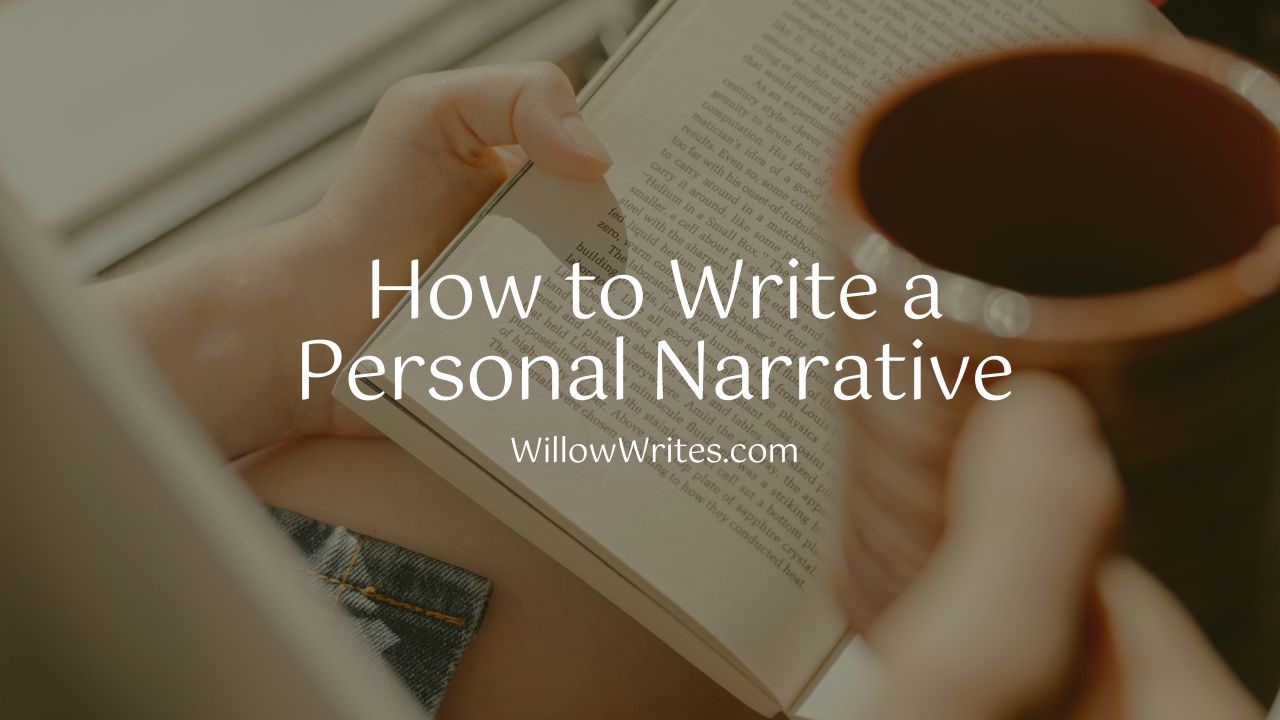
How to Write a Personal Narrative [in 10 Easy Steps]
- Writing Tips
Writing in Third Person – Examples & Worksheet
| Candace Osmond
Candace Osmond
Candace Osmond studied Advanced Writing & Editing Essentials at MHC. She’s been an International and USA TODAY Bestselling Author for over a decade. And she’s worked as an Editor for several mid-sized publications. Candace has a keen eye for content editing and a high degree of expertise in Fiction.
The third-person narrative is often employed in narrative writing because it zooms in and out of character perspectives to describe actions, feelings, emotions, and thoughts. If you’re unsure how to use the 3rd person perspective in writing, here are some tips and examples.
What is Third Person Narrative?

The third person is one of three perspectives employed in speaking and writing. It’s used to describe the point of view of a third party and uses a variety of pronouns derived from he, her, and it. Books written in third person are often more popular, as well, for their ease of reading.
I often write in first-person narrative, but when I’m writing a complex story from the point of view of multiple characters, I use third person to make things more rounded and streamlined for the reader.
Using Third Person
Third person is a perspective used based on whoever the story or writing in question is about. The subject pronoun is outside of the narrator themself. Third-person texts do not include the perspective of the narrator/writer, nor does it address the reader directly. It also uses certain personal pronouns and possessive pronouns.
Example of a third person sentence:
Jeremy knew it was destined to be. He placed the dog in the backseat of his car and drove away. All he wanted at that time was to ensure the animal got the loving home he deserved.
Third Person Possessive Adjectives in Third Person
So, instead of using me, mine, ours, etc., you would use hers, his, theirs when writing in third person.
Does “You” Belong in 3rd Person Writing?
Third-person writing requires using third-person pronouns, including he, she, it, him, her, them, themselves, himself, herself, or a name. Using “you” means you’re switching to the second person.
How to Introduce Yourself in the Third Person
People typically use the first-person point of view when talking about themselves and their experiences. It would be odd to talk about oneself in the third person all the time, but you might use it occasionally for the sake of humorous effect or attract the attention of another person.
The third person introduces a third party to the person you’re speaking with. If you are a narrator, it’s best to introduce yourself in the first person and start narrating the events in the third person.
How to Start a Story in Third Person

In a story, narrators use the third person if they are not part of the story themselves. Third-person narratives show us a person’s actions, feelings, and thoughts.
Example of how to write in third person:
Nadia dreamt about being a gymnast her entire life. Ever since she can remember, she’s worked hard, sacrificed a lot, and hoped someone would notice all her efforts. She was never the smartest kid in school, but she believed in herself enough to never give up on that spot on the podium.
What Are the 3 Types of 3rd Person?
In writing, there are three ways to approach third-person writing.
Third-Person Omniscient
The story’s narrator is all-knowing and can see into the past, present, and future. This narrator can assume other people’s perspectives, jumping around in time and providing the reader with their thoughts and observations.
Third-Person Limited Omniscient
In this point of view, the author focuses on one persona and never switches to another. In a novel, the narrator may use this technique throughout the work or employ it in alternating chapters or sections.
The author can regulate the reader’s knowledge and experience by writing from a limited point of view. Used effectively, it can create a palpable sense of anticipation and excitement.
Third-Person Objective
The narrator of a story told from the third-person objective perspective is unbiased and does not share the viewpoint of the character’s emotional reactions. The story is told in an objective, third-person style.
How to Write In Third Person About Yourself
The easiest way to approach this problem is to create a character. You can also use your actual name to write from the third-person perspective.
Why Write in Third-Person?
Fiction writing uses third-person POV quite often. Here are some advantages of employing it as part of your narrative style.
Strong Character Growth Is Emphasized
More characters can be highlighted in a story told from the third-person perspective than in the first- or second-person. These varying perspectives give the reader a complete understanding of the story since they shed light on the plot in ways the other characters cannot.
It Employs Flexible Narrative Possibilities
The advantages of writing in the third person include greater freedom to move around, giving the reader a comprehensive view, and shifting perspectives among multiple characters. You can switch between being completely all-knowing and having only partial or first-person knowledge.
This latter technique allows the reader to experience the world through the eyes of a character, allowing for a more profound understanding of that person and their surroundings.
Makes the Author More Reliable
Third-person narration places the reader in a vantage point far above the action. With the author/narrator not part of the story, they can rise above it, having nothing to lose or gain from certain narrative developments. This makes the story more reliable and lends the story more authority and credibility.
First, Second, and Third Person Pronouns
If you’re confused about the types of pronouns used in each of the three main perspectives, here is a comprehensive list:
- First person pronouns: I, me, mine, myself, we, us, ourselves, ours.
- Second person pronouns: you, your, yours.
- Third person singular pronouns: he, him, his, she, her, it,
- Third person plural pronouns: its, itself, they, them, their, theirs, themselves.
Bottom Line on Third Person
Writing in 3rd person grants the author more credibility and offers a more objective perspective of the characters in the text. Often employed in fictional and academic writing, the third-person point of view makes the text seem more authentic and factually correct.
Grammarist is a participant in the Amazon Services LLC Associates Program, an affiliate advertising program designed to provide a means for sites to earn advertising fees by advertising and linking to Amazon.com. When you buy via the links on our site, we may earn an affiliate commission at no cost to you.
2024 © Grammarist, a Found First Marketing company. All rights reserved.
- PRO Courses Guides New Tech Help Pro Expert Videos About wikiHow Pro Upgrade Sign In
- EDIT Edit this Article
- EXPLORE Tech Help Pro About Us Random Article Quizzes Request a New Article Community Dashboard This Or That Game Popular Categories Arts and Entertainment Artwork Books Movies Computers and Electronics Computers Phone Skills Technology Hacks Health Men's Health Mental Health Women's Health Relationships Dating Love Relationship Issues Hobbies and Crafts Crafts Drawing Games Education & Communication Communication Skills Personal Development Studying Personal Care and Style Fashion Hair Care Personal Hygiene Youth Personal Care School Stuff Dating All Categories Arts and Entertainment Finance and Business Home and Garden Relationship Quizzes Cars & Other Vehicles Food and Entertaining Personal Care and Style Sports and Fitness Computers and Electronics Health Pets and Animals Travel Education & Communication Hobbies and Crafts Philosophy and Religion Work World Family Life Holidays and Traditions Relationships Youth
- Browse Articles
- Learn Something New
- Quizzes Hot
- This Or That Game
- Train Your Brain
- Explore More
- Support wikiHow
- About wikiHow
- Log in / Sign up
- Education and Communications
- Editing and Style
How to Write in Third Person
Last Updated: May 10, 2024 Fact Checked
This article was co-authored by Alicia Cook . Alicia Cook is a Professional Writer based in Newark, New Jersey. With over 12 years of experience, Alicia specializes in poetry and uses her platform to advocate for families affected by addiction and to fight for breaking the stigma against addiction and mental illness. She holds a BA in English and Journalism from Georgian Court University and an MBA from Saint Peter’s University. Alicia is a bestselling poet with Andrews McMeel Publishing and her work has been featured in numerous media outlets including the NY Post, CNN, USA Today, the HuffPost, the LA Times, American Songwriter Magazine, and Bustle. She was named by Teen Vogue as one of the 10 social media poets to know and her poetry mixtape, “Stuff I’ve Been Feeling Lately” was a finalist in the 2016 Goodreads Choice Awards. There are 7 references cited in this article, which can be found at the bottom of the page. This article has been fact-checked, ensuring the accuracy of any cited facts and confirming the authority of its sources. This article has been viewed 1,141,969 times.
Writing in third person can be a simple task, with a little practice. For academic purposes, third person writing means that the writer must avoid using subjective pronouns like “I” or “you.” For creative writing purposes, there are differences between third person omniscient, limited, objective, and episodically limited points of view. Choose which one fits your writing project.
Writing Third Person Point of View
The third-person point of view discusses the person or people being talked about in academic or creative writing. In this perspective, you’d shift focus from subject to subject. Use pronouns like he/him, she/her, they/them, or it/itself.
Writing in Third Person Academically

- Third person helps the writing stay focused on facts and evidence instead of personal opinion.

- Third person pronouns include: he, she, it; his, her, its; him, her, it; himself, herself, itself; they; them; their; themselves.
- Names of other people are also considered appropriate for third person use.
- Example: “ Smith believes differently. According to his research, earlier claims on the subject are incorrect.”

- First person pronouns include: I, me, my, mine, myself, we, us, our, ours, ourselves. [3] X Research source
- The problem with first person is that, academically speaking, it sounds too personalized and too subjective. In other words, it may be difficult to convince the reader that the views and ideas being expressed are unbiased and untainted by personal feelings. Many times, when using first person in academic writing, people use phrases like "I think," "I believe," or "in my opinion."
- Incorrect example: “Even though Smith thinks this way, I think his argument is incorrect.”
- Correct example: “Even though Smith thinks this way, others in the field disagree.”

- Second person pronouns include: you, your, yours, yourself. [4] X Research source
- One main problem with second person is that it can sound accusatory. It runs to risk of placing too much responsibility on the shoulders of the reader specifically and presently reading the work.
- Incorrect example: “If you still disagree nowadays, then you must be ignorant of the facts.”
- Correct example: “Someone who still disagrees nowadays must be ignorant of the facts.”

- Indefinite third person nouns common to academic writing include: the writer, the reader, individuals, students, a student, an instructor, people, a person, a woman, a man, a child, researchers, scientists, writers, experts.
- Example: “In spite of the challenges involved, researchers still persist in their claims.”
- Indefinite third person pronouns include: one, anyone, everyone, someone, no one, another, any, each, either, everybody, neither, nobody, other, anybody, somebody, everything, someone.
- Incorrect example: "You might be tempted to agree without all the facts."
- Correct example: “ One might be tempted to agree without all the facts.”
- This is usually done in an attempt to avoid the gender-specific “he” and “she” pronouns. The mistake here would be to use the “they” pronoun with singular conjugation. [5] X Research source
- Incorrect example: “The witness wanted to offer anonymous testimony. They was afraid of getting hurt if their name was spread.”
- Correct example: “The witness wanted to offer anonymous testimony. They were afraid of getting hurt if their name was spread.”
Writing in Third Person Omniscient

- For instance, a story may include four major characters: William, Bob, Erika, and Samantha. At various points throughout the story, the thoughts and actions of each character should be portrayed. These thoughts can occur within the same chapter or block of narration.
- Writers of omniscient narratives should be conscious of “head-hopping” — that is, shifting character perspectives within a scene. While this does not technically break the rules of Third Person Omniscience, it is widely considered a hallmark of narrative laziness.
- In a sense, the writer of a third person omniscient story is somewhat like the “god” of that story. The writer can observe the external actions of any character at any time, but unlike a limited human observer, the writer can also peek into the inner workings of that character at will, as well.
- Know when to hold back. Even though a writer can reveal any information they choose to reveal, it may be more beneficial to reveal some things gradually. For instance, if one character is supposed to have a mysterious aura, it would be wise to limit access to that character's inner feelings for a while before revealing his or her true motives.

- Do not use first person and second person points of view in the narrative or descriptive portions of the text.
- Correct example: Bob said to Erika, “I think this is creepy. What do you think?”
- Incorrect example: I thought this was creepy, and Bob and Erika thought so, too. What do you think?
Writing in Third Person Limited

- The thoughts and feelings of other characters remain an unknown for the writer throughout the duration of the text. There should be no switching back and forth between characters for this specific type of narrative viewpoint.
- Unlike first person, where the narrator and protagonist are the same, third person limited puts a critical sliver of distance between protagonist and narrator. The writer has the choice to describe one main character’s nasty habit — something they wouldn’t readily reveal if the narration were left entirely to them.

- In other words, do not use first person pronouns like “I,” “me,” “my,” “we,” or “our” outside of dialog. The main character's thoughts and feelings are transparent to the writer, but that character should not double as a narrator.
- Correct example: “Tiffany felt awful after the argument with her boyfriend.”
- Correct example: “Tiffany thought, “I feel awful after that argument with my boyfriend.”
- Incorrect example: “I felt awful after the argument with my boyfriend.”

- Note that the writer can offer insight or guesses regarding the thoughts of other characters, but those guesses must be presented through the perspective of the main character.
- Correct example: “Tiffany felt awful, but judging by the expression on Carl's face, she imagined that he felt just as bad if not worse.”
- Incorrect example: “Tiffany felt awful. What she didn't know was that Carl felt even worse.”

- Correct example: “Tiffany watched from the window as Carl walked up to her house and rang the doorbell.”
- Incorrect example: “As soon as Tiffany left the room, Carl let out a sigh of relief.”
Writing in Episodically Limited Third Person

- Limit the amount of pov characters you include. You don't want to have too many characters that confuse your reader or serve no purpose. Each pov character should have a specific purpose for having a unique point of view. Ask yourself what each pov character contributes to the story.
- For instance, in a romance story following two main characters, Kevin and Felicia, the writer may opt to explain the inner workings of both characters at different moments in the story.
- One character may receive more attention than any other, but all main characters being followed should receive attention at some point in the story.

- Multiple perspectives should not appear within the same narrative space. When one character's perspective ends, another character's can begin. The two perspectives should not be intermixed within the same space.
- Incorrect example: “Kevin felt completely enamored of Felicia from the moment he met her. Felicia, on the other hand, had difficulty trusting Kevin.”

- In a novel-length work, a good time to switch perspective is at the start of a new chapter or at a chapter break.
- The writer should also identify the character whose perspective is being followed at the start of the section, preferably in the first sentence. Otherwise, the reader may waste too much energy guessing.
- Correct example: “Felicia hated to admit it, but the roses Kevin left on her doorstep were a pleasant surprise.”
- Incorrect example: “The roses left on the doorstep seemed like a nice touch.”

- For instance, if Kevin had a talk with Felicia's best friend about Felicia's feelings for him, Felicia herself would have no way of knowing what was said unless she witnessed the conversation or heard about it from either Kevin or her friend.
Writing in Third Person Objective

- There does not need to be a single main character to focus on. The writer can switch between characters, following different characters throughout the course of the narrative, as often as needed.
- Stay away from first person terms like “I” and second person terms like “you” in the narrative, though. Only use first and second person within dialog.

- Imagine that you are an invisible bystander observing the actions and dialog of the characters in your story. You are not omniscient, so you do not have access to any character's inner thoughts and feelings. You only have access to each character's actions.
- Correct example: “After class, Graham hurriedly left the room and rushed back to his dorm room.”
- Incorrect example: “After class, Graham raced from the room and rushed back to his dorm room. The lecture had made him so angry that he felt as though he might snap at the next person he met.”

- Correct example: “When no one else was watching her, Isabelle began to cry.”
- Incorrect example: “Isabelle was too prideful to cry in front of other people, but she felt completely broken-hearted and began crying once she was alone.”

- Let the reader draw his or her own conclusions. Present the actions of the character without analyzing them or explaining how those actions should be viewed.
- Correct example: “Yolanda looked over her shoulder three times before sitting down.”
- Incorrect example: “It might seem like a strange action, but Yolanda looked over her shoulder three times before sitting down. This compulsive habit is an indication of her paranoid state of mind.”
Examples of Third Person POV

Expert Q&A

You Might Also Like

- ↑ https://stlcc.edu/student-support/academic-success-and-tutoring/writing-center/writing-resources/point-of-view-in-academic-writing.aspx
- ↑ http://studysupportresources.port.ac.uk/Writing%20in%20the%20third%20peson.pdf
- ↑ http://www.grammar-monster.com/glossary/third_person.htm
- ↑ https://www.grammarly.com/blog/use-the-singular-they/
- ↑ Alicia Cook. Professional Writer. Expert Interview. 11 December 2020.
- ↑ https://www.merriam-webster.com/words-at-play/point-of-view-first-second-third-person-difference
- ↑ https://ojs.library.dal.ca/YAHS/article/viewFile/7236/6278
About This Article

To write in third person, refer to people or characters by name or use third person pronouns like he, she, it; his, her, its; him, her, it; himself, herself, itself; they; them; their; and themselves. Avoid first and second person pronouns completely. For academic writing, focus on a general viewpoint rather than a specific person's to keep things in third person. In other types of writing, you can write in third person by shifting your focus from character to character or by focusing on a single character. To learn more from our Literary Studies Ph.D., like the differences between third person omniscient and third person limited writing, keep reading the article! Did this summary help you? Yes No
- Send fan mail to authors
Reader Success Stories
Jul 31, 2016
Did this article help you?
Jean Scicluna
Jan 31, 2021
Nov 4, 2016
Karen Evans
Aug 5, 2016
Oct 20, 2016

Featured Articles

Trending Articles

Watch Articles

- Terms of Use
- Privacy Policy
- Do Not Sell or Share My Info
- Not Selling Info
Get all the best how-tos!
Sign up for wikiHow's weekly email newsletter
7 Essential Tips for Writing in the Third Person

Table of contents

Alana Chase
Whether you’re a student, business professional, or writer, knowing how to write well in the third person is an essential skill.
But you may not be sure of all the rules or how to make your third-person writing shine.
As an editor and writing coach of 11 years, I’ve taught students and writers at all levels how to master the third-person point of view (POV). All you need to get started is a good understanding of third-person pronouns and a bit of practice for consistency.
By the end of this article, you’ll know when and how to use third-person perspective. You'll also find helpful tips for taking your third-person writing to the next level.
Key takeaways
- In the third-person perspective, the narrator is separate from the story.
- Third-person perspective uses he/him/his, she/her/hers, and they/them/their pronouns.
- Consistency is key: Don’t switch between perspectives in a single document.
- Practicing third-person writing and editing your work is vital to improving your skills.
What is third-person point of view (POV)?
In writing, there are three ways to tell a story: first-person, second-person, or third-person POV.
First-person POV is from the narrator’s perspective:
“ I saw the bird steal my sandwich, and I ran after it.”
Second-person POV is from the reader’s perspective:
“ You saw the bird steal your sandwich, and you ran after it.”
Third-person POV, however, separates the narrator from the story and uses third-person pronouns (like he/him, she/her, and they/them) to describe events, actions, thoughts, and emotions. Characters are referred to by name or one of these pronouns:
“ Alex saw the bird steal his/her/their sandwich, and he/she/they ran after it.”
Third-person POV is used in all kinds of writing — from novels to research papers, journalistic articles, copywriting materials, and more. Check out some examples below.
Examples of third-person perspective
- In a novel: “Robb and Jon sat tall and still on their horses, with Bran between them on his pony, trying to seem older than seven, trying to pretend that he’d seen all this before.” (From A Game of Thrones by George R. R. Martin)
- In a news article : “This weekend, Iceland experienced nearly 2,000 earthquakes within 48 hours. And they’ve kept coming since then – in swarms.” (From “Thousands of earthquakes have scientists watching for a volcanic eruption in Iceland” on NPR’s website )
- In copywriting : “Balm Dotcom’s formula has antioxidants and natural emollients to nourish dry lips.” (Website copy describing Glossier’s Balm Dotcom lip product )
7 tips for writing in the third person
Just like the first and second person, you’ve probably already written in the third person before. But to do it well , you’ll need some key tips and tricks in your writing toolkit.
Let’s dive into the seven essentials for third-person writing.
Tip 1: Use third-person determiners and pronouns
In grammar, determiners introduce and modify nouns. They’re used to specify what a noun refers to (like “ my laptop”) or the quantity of it (like “ many sandwiches”).
Meanwhile, pronouns are substitutes for nouns, referring to people, places, or things. For example, “Caroline [noun] is a skilled musician, and she [pronoun] especially loves playing the piano.”
When you write in the third person, use only third-person determiners and pronouns. Let’s take a look at the different types of pronouns.

Tip 2: Use names for clarity
In third-person writing, using names is crucial for clarity, especially when multiple people/characters share similar pronouns. Strategically incorporate names into your writing to help readers keep track of who’s who.
For example:
“She submitted the script draft to her, and she made suggestions for changes.”
“Mira submitted the script draft to Lynn, and Lynn made suggestions for changes.”
Tip: Use a character or person’s name when introducing them in your writing. Then, alternate between using pronouns and their name to prevent confusion.
Tip 3: Keep the narration neutral
When you write in the third person, your narrator is an uninvolved observer. They have no opinions on the people, places, things, or events they describe. Their words and tone should be neutral (but not boring).
To achieve this in your writing:
- Think of your narrator as a reporter. Their job is to detail what’s happening, when and why it’s occurring, who’s involved, and any background information that can give context. They don’t offer a personal interpretation of events. Instead, they provide facts and supporting details.
- Save the judgment for characters. Rather than having your narrator share their critique of events or individuals, have a character offer their opinion — either through dialogue, actions, or reactions. For instance, instead of writing, “Dr. Shaw was a courageous woman,” let a character convey admiration by telling Dr. Shaw, “I’ve always admired your fearlessness.”
- Be objective with your descriptions. Avoid subjective adjectives and focus on observable features. For example, instead of describing a landscape as “breathtaking,” write that it’s “marked with snow-capped mountains and patches of tall pine trees.”
Tip 4: Use descriptive language
Showing — and not just telling — is essential when writing in the third person. Instead of stating emotions and experiences outright, immerse your reader in your character’s reality. Create vivid descriptions of their thoughts, feelings, and surroundings. Use language that engages the senses: sight, sound, smell, touch, and taste.
For example:
“Aisha was nervous.”
“Aisha’s hands trembled, and her tongue felt dry against the roof of her mouth. The spotlight above the stage shone white-hot, causing beads of sweat to form along Aisha’s hairline.”
Tip 5: Be consistent
Once you establish a third-person POV, stick to it . Avoid switching from the third person to the first or second person. Otherwise, you’ll confuse the reader and disrupt the flow of your writing.
“Hannah felt a surge of excitement when her telephone rang, anticipating good news about her mortgage application. I felt my heart rate quicken as I answered.” (Switches from the third person to the first person)
“Hannah felt a surge of excitement when her telephone rang, anticipating good news about her mortgage application. She felt her heart rate quicken as she answered.” (Remains in the third person)
Tip 6: Practice
Writing in the third person might feel strange at first, especially if you’re used to using the first or second person. However, it’ll come more naturally to you with practice.
Here are two writing exercises you can try right now:
Writing Exercise #1
Take an excerpt from an article or book written in the first or second person and rewrite it in the third person. Below is an example using The Catcher in the Rye , whose main character is named Holden.
Before: “The other reason I wasn’t down at the game was because I was on my way to say good-by to old Spencer, my history teacher.”
After: “The other reason Holden wasn’t down at the game was because he was on his way to say good-by to old Spencer, his history teacher.”
Writing Exercise #2
Turn on a movie or television show, mute the sound, and closely observe two characters. Give them each a name. Using third-person pronouns and their names, describe the characters’ actions and what you believe they’re thinking and feeling.
Above all, write in the third person as often as possible , following the tips in this guide. Remember, your writing skills are like muscles: The more you exercise them, the stronger they become.
Tip 7: Carefully revise
After you’ve written something in the third person, carefully review and revise your work.
Check that your writing :
- Uses third-person determiners and pronouns accurately and consistently
- Incorporates names where pronouns may cause confusion
- Maintains a neutral tone, where your narrator doesn’t offer personal opinions or interpretations
- Doesn’t shift to the first or second person
Make changes where necessary, then read through your work a final time.
AI tip: Wordtune can help you self-edit and help improve your writing overall.
Paste your work into Wordtune’s Editor, or write in it directly, and use the features to shorten or expand your sentences, make your tone more casual or formal, and more. Wordtune will also automatically flag spelling and grammar errors and suggest ways to improve concision, clarity, and flow.

Get Wordtune for free > Get Wordtune for free >
Bonus tip (advanced): Learn the different types of third-person POV
Did you know there are three types of third-person POV? Getting familiar with them can help you make your writing even more impactful.
- Third-person objective , where the narrator is “a fly on the wall”: They provide an objective account of events without exploring people/characters’ emotions or thoughts.
- Third-person omniscient , where the narrator has unlimited knowledge of all events and characters’ thoughts and feelings.
- Third-person limited , also called “close third,” where the narrator has access to just one character’s emotions, thoughts, and experiences.
With this knowledge, you can choose the right perspective for your writing depending on its purpose, tone, and goals.
For instance, use third-person omniscient to show readers what’s happening with everyone in your novel. Or, you could go for third-person objective in an academic paper where you must present facts without sharing your interpretation of them.
Writing well in the third person takes thought and effort. You must use third-person determiners and pronouns, weave in descriptive language, and keep your narration neutral. You also need to be consistent with your POV, ensuring you don’t accidentally switch to the first or second person. Finally, review and revise your work to make sure it’s clear and error-free.
Using this guide — and Wordtune’s tools to polish your writing — you’ll get the hang of the third-person perspective in no time.
To continue sharpening your writing skills, read our articles on mastering tone of voice and writing concisely (with help from AI). Then, check out our proofreading guide to keep your work flawless .
What is a third-person word example?
Third-person words are pronouns like “he,” “her,” “they,” “it,” “hers,” and “theirs.”
Should I write in the first or third person?
It depends on the closeness you want to create with your audience. The first person allows for a personal connection between the narrator and the reader, while the third person creates distance between the narrator and the audience.
What are the disadvantages of writing in the third person?
Third-person writing can lead to a lack of intimacy with the reader. This can be a disadvantage for some writers but an advantage for others, like those in academic and professional settings.
Share This Article:
.webp)
8 Key Elements of a Research Paper Structure + Free Template (2024)
.webp)
How to Craft Your Ideal Thesis Research Topic

How to Craft an Engaging Elevator Pitch that Gets Results
Looking for fresh content, thank you your submission has been received.
BibGuru Blog
Be more productive in school
- Citation Styles
How to write in third-person

Although there are three narratives you can use in any form of writing when it comes to your papers and anything academic you produce, it’s best to choose the third-person. It’s pretty simple with a bit of practice, but if you’re completely new to this writing style, here’s what you need to know about how to write in third-person.
What does writing in third-person mean?
Writing in third-person is one of the three styles you can use when describing a point of view. Even though you might not know it, chances are you’ve used first, second and third person in writing projects throughout your education.
It’s a narrative where you’re totally independent of the subject you’re analyzing and writing about. You don’t take sides. You don’t try to influence what readers feel. It’s a completely unbiased, objective way of writing that tells a story or dissects a topic right down the middle.
There’s a lot of information out there about how you can differentiate between the three in roundabout ways, making it unnecessarily complicated. Here’s a quick breakdown to understand the differences for when you write your following paper:
First-person
This is from the I/we perspective. It’s where we talk about us , ourselves, and our opinions. If we go down the first-person route, writing will include pronouns like I , me , myself, and mine .

Second-person
This point of view belongs to the person you’re addressing — so its a you perspective. In your writing, you’d use second-person pronouns such as you , your, and yourselves .
Third-person
The third-person point of view is aimed at the person or people being talked about, which is the type of writing you’d find in stories. In this perspective, you’d use pronouns like he , she , him , her , his , hers , himself , herself , it , them , their, and themselves . Or, you’d use a name. But that tends to happen more in stories than research papers.
Notice the difference between the three?
When to write in third-person
The third-person point of view tells the reader a story and it’s often the go-to when you’re taking an authoritative stance in your papers, which is why it’s so common in academic writing.
So, always choose the third-person stance when writing academic copy, such as essays and research papers.
The reason for this is it’ll make your papers less personal and more objective, meaning the objectivity will make you come across as more credible and less biased. Ultimately, this will help your grades as the third-person view keeps you focused on evidence and facts instead of your opinion.
You can break third-person perspectives into three other types, including omniscient, limited, and objective. Although they’re more associated with creative writing than academic work and essays, your writing is likely to fall under the third-person objective point of view.
A third-person objective point of view is about being neutral and presenting your findings and research in an observational way, rather than influencing the reader with your opinions.
How to use the third-person point of view
Rule number one: Never refer to yourself in your essay in the third-person. That’s a no-no.
For instance, here’s how you shouldn’t write a sentence in your essay if you’re writing about virtual learning as an example.
“I feel like students perform better at home because they have more freedom and are more comfortable.”
It’s a simple sentence, but there’s a lot wrong with it when you’re talking about research papers and adopting a third-person narrative. Why? Because you’re using first-person pronouns and, as it sounds like an opinion, you can’t back up your claims with a stat or any credible research. There’s no substance to it whatsoever.
Also, it isn’t very assertive. The person marking your work won’t be impressed by “I feel like,” because it shows no authority and highlights that it came from your brain and not anywhere of note.
By including terms like “I think” or “I feel” like in the example above, you’re already off to a bad start.
But when you switch that example to the third-person point of view, you can cite your sources , which is precisely what you need to do in your essays and research papers to achieve higher grades.
Let’s switch that sentence up and expand it using the third-person point of view:
“A psychological study from Karrie Goodwin shows that students thrive in virtual classrooms as it offers flexibility. They can make their own hours and take regular breaks. Another study from high school teacher, Ashlee Trip, highlighted that children enjoy freedom, the ability to work at their own pace and decide what their day will look like.”
With a third-person narrative, you can present evidence to the reader and back up the claims you make. So, it not only shows what you know, but it also shows you took the time to research and strengthen your paper with credible resources and facts — not just opinions.
6 tips for writing in third-person
1. understand your voice won’t always shine in your essays.
Every single piece of writing tends to have a voice or point of view as if you’re speaking to the reader directly. However, that can’t always happen in academic writing as it’s objective compared to a novel, for example. Don’t try to ‘fluff’ up your piece to try and cram your personality in, as your academic work doesn’t need it.
2. Don’t focus on yourself or the reader — focus on the text
An academic piece of work always has a formal tone as it’s objective. When you write your next paper, focus on the writing itself rather than the writer or the reader.
3. Coach yourself out of using first-person pronouns
This is easier said than done if all you’ve ever done is first- or second-person writing. When you write your next paper, scan through it to see if you’ve written anything in first-person and replace it with the third-person narrative.
Here are a few regular offenders that pop up in academic papers — along with how you can switch the statements to third-person:
- I argue should be this essay argues
- I found that should be it was found that
- We researched should be the group researched
- I will also analyze should be topic X will also be analyzed
The same applies to second-person, as there are plenty of cases where it tends to slip through in academic writing. Again, it’s pretty straightforward to switch the more you practice. For instance:
- Your paper will be marked higher if you use a citation tool should be the use of a citation tool will improve one’s grades
4. Be as specific as possible
This is where things can get a little bit confusing. Writing in third-person is all about including pronouns like he, she, it, and they. However, using them towards the beginning of sentences can be pretty vague and might even confuse the reader — this is the last thing you want from your essay or paper.
Instead, try using nouns towards the beginning of sentences. For example, use the actual subject, such as the interviewer or the writer, rather than he, she, or they when you begin the sentence.
The same applies to terms like it. Start the sentence with the ‘it’ is that you’re describing. If it’s a citation tool, begin the sentence by referencing what you’re discussing, so you aren’t vague. Clarity is key.
5. Write in the present tense when using third-person
In any form of academic writing, you need to write your reports, essays, and research papers in the present tense, especially when introducing different subjects or findings.
So, rather than saying “This paper analyzed” (which does seem correct as technically that part was in the past and the writing is in the present), you should write “This report analyzes” — as if you’re analyzing right here and now.
However, the difference is when you highlight how you did the research, that should be in the past tense. This means you’d use third-person phrases like “The equipment that was used” or “The results were analyzed by”, for instance.
6. Avoid adding your own thoughts
If your report is on a subject that’s close to your heart, it can be super tempting to sprinkle in your own thoughts. It’s a challenge, but you need to coach yourself out of it.
In academic writing, you aren’t a commentator. You’re a reporter. You need to let readers draw their conclusions without over-analyzing them or making the reader lean one way or another.
The easiest way to get to grips with writing your academic papers in the third-person is to be consistent and practice often. Criticize your work and analyze it until it becomes the norm. Yes, it can be a little complex in the early days, but before you know it, you’d have mastered the technique, helping you take your papers and reports up a level.
Frequently Asked Questions about writing in third-person
In third-person, you’d use pronouns like he , she , him , her , his , hers , himself , herself , it , them , their, and themselves . Or, you’d use a name.
You is used in second person and is therefore not used in third person. The second person is used for the person that is being addressed.
The third-person point of view is aimed at the person or people being talked about, which is the type of writing you’d find in stories. When writing in third-person view, make sure to write in the present tense and avoid adding your own thoughts.
When writing in third person, you should actually always write in the present tense since you are mostly presenting results in this view.
The second person point of view belongs to the person you’re addressing — so its a you perspective. In your writing, you’d use second-person pronouns such as you , your, and yourselves .

Make your life easier with our productivity and writing resources.
For students and teachers.
Frequently asked questions
Can i write about myself in the third person.
In most contexts, you should use first-person pronouns (e.g., ‘I’, ‘me’) to refer to yourself. In some academic writing, the use of the first person is discouraged, and writers are advised to instead refer to themselves in the third person (e.g., as ‘the researcher’).
This convention is mainly restricted to the sciences, where it’s used to maintain an objective, impersonal tone. But many style guides (such as APA Style ) now advise you to simply use the first person, arguing that this style of writing is misleading and unnatural.
Ask our team
Want to contact us directly? No problem. We are always here for you.
- Chat with us
- Email [email protected]
- Call +44 (0)20 3917 4242
- WhatsApp +31 20 261 6040

Our support team is here to help you daily via chat, WhatsApp, email, or phone between 9:00 a.m. to 11:00 p.m. CET.
Our APA experts default to APA 7 for editing and formatting. For the Citation Editing Service you are able to choose between APA 6 and 7.
Yes, if your document is longer than 20,000 words, you will get a sample of approximately 2,000 words. This sample edit gives you a first impression of the editor’s editing style and a chance to ask questions and give feedback.
How does the sample edit work?
You will receive the sample edit within 24 hours after placing your order. You then have 24 hours to let us know if you’re happy with the sample or if there’s something you would like the editor to do differently.
Read more about how the sample edit works
Yes, you can upload your document in sections.
We try our best to ensure that the same editor checks all the different sections of your document. When you upload a new file, our system recognizes you as a returning customer, and we immediately contact the editor who helped you before.
However, we cannot guarantee that the same editor will be available. Your chances are higher if
- You send us your text as soon as possible and
- You can be flexible about the deadline.
Please note that the shorter your deadline is, the lower the chance that your previous editor is not available.
If your previous editor isn’t available, then we will inform you immediately and look for another qualified editor. Fear not! Every Scribbr editor follows the Scribbr Improvement Model and will deliver high-quality work.
Yes, our editors also work during the weekends and holidays.
Because we have many editors available, we can check your document 24 hours per day and 7 days per week, all year round.
If you choose a 72 hour deadline and upload your document on a Thursday evening, you’ll have your thesis back by Sunday evening!
Yes! Our editors are all native speakers, and they have lots of experience editing texts written by ESL students. They will make sure your grammar is perfect and point out any sentences that are difficult to understand. They’ll also notice your most common mistakes, and give you personal feedback to improve your writing in English.
Every Scribbr order comes with our award-winning Proofreading & Editing service , which combines two important stages of the revision process.
For a more comprehensive edit, you can add a Structure Check or Clarity Check to your order. With these building blocks, you can customize the kind of feedback you receive.
You might be familiar with a different set of editing terms. To help you understand what you can expect at Scribbr, we created this table:
View an example
When you place an order, you can specify your field of study and we’ll match you with an editor who has familiarity with this area.
However, our editors are language specialists, not academic experts in your field. Your editor’s job is not to comment on the content of your dissertation, but to improve your language and help you express your ideas as clearly and fluently as possible.
This means that your editor will understand your text well enough to give feedback on its clarity, logic and structure, but not on the accuracy or originality of its content.
Good academic writing should be understandable to a non-expert reader, and we believe that academic editing is a discipline in itself. The research, ideas and arguments are all yours – we’re here to make sure they shine!
After your document has been edited, you will receive an email with a link to download the document.
The editor has made changes to your document using ‘Track Changes’ in Word. This means that you only have to accept or ignore the changes that are made in the text one by one.
It is also possible to accept all changes at once. However, we strongly advise you not to do so for the following reasons:
- You can learn a lot by looking at the mistakes you made.
- The editors don’t only change the text – they also place comments when sentences or sometimes even entire paragraphs are unclear. You should read through these comments and take into account your editor’s tips and suggestions.
- With a final read-through, you can make sure you’re 100% happy with your text before you submit!
You choose the turnaround time when ordering. We can return your dissertation within 24 hours , 3 days or 1 week . These timescales include weekends and holidays. As soon as you’ve paid, the deadline is set, and we guarantee to meet it! We’ll notify you by text and email when your editor has completed the job.
Very large orders might not be possible to complete in 24 hours. On average, our editors can complete around 13,000 words in a day while maintaining our high quality standards. If your order is longer than this and urgent, contact us to discuss possibilities.
Always leave yourself enough time to check through the document and accept the changes before your submission deadline.
Scribbr is specialised in editing study related documents. We check:
- Graduation projects
- Dissertations
- Admissions essays
- College essays
- Application essays
- Personal statements
- Process reports
- Reflections
- Internship reports
- Academic papers
- Research proposals
- Prospectuses
Calculate the costs
The fastest turnaround time is 24 hours.
You can upload your document at any time and choose between four deadlines:
At Scribbr, we promise to make every customer 100% happy with the service we offer. Our philosophy: Your complaint is always justified – no denial, no doubts.
Our customer support team is here to find the solution that helps you the most, whether that’s a free new edit or a refund for the service.
Yes, in the order process you can indicate your preference for American, British, or Australian English .
If you don’t choose one, your editor will follow the style of English you currently use. If your editor has any questions about this, we will contact you.
How to Do the Write Thing
Get Paid to Write through the Power of Storytelling and Make Money Online to Work from Home
Everything You Need to Know for Writing in Third Person | 11 Tips
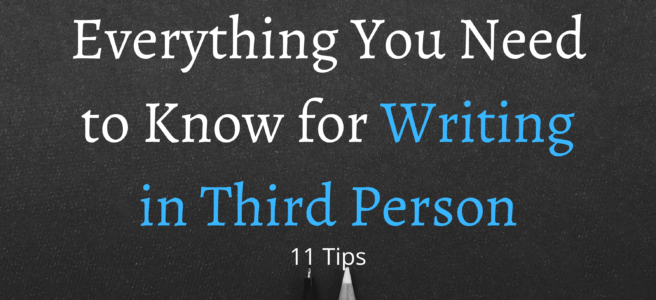
Everything You Need to Know for Writing in Third Person
What is writing in third person point of view?
“In third-person point of view, the author is narrating a story about the characters, referring to them by name, or using the third-person pronouns “he,“” she,” and “they.” The other points of view in writing are first person and second person.” Source.
What does writing in third person mean?
“When you are writing in the third person, the story is about other people. Not yourself or the reader. Use the character’s name or pronouns such as ‘he’ or ‘she’.”
What are the 3 types of third person point of view?
1. third-person omniscient point of view: .
“The omniscient narrator knows everything about the story and its characters. This narrator can enter any character’s mind, move freely through time, and give the reader their own opinions and observations as well as those of the characters. For example, Jane Austen’s Pride and Prejudice is told from a third-person omniscient point of view, giving the reader full access to the main character, Elizabeth, as well as the characters around her.” Source.
2. Third-person limited point of view:
“The third-person limited point of view (often called a “close third”) is when an author sticks closely to a single character but remains in third-person. The narrator can do this for the entire novel or switch between different characters for different chapters or sections. This point of view allows the author to limit a reader’s perspective and control what information the reader knows. It is used to build interest and heighten suspense.” Source.
3. Third-person objective point of view:
“Third-person objective point of view has a neutral narrator that is not privy to any character’s thoughts or feelings. The narrator presents the story with an observational tone. Ernest Hemingway employs this third-person narrative voice in his short story “Hills Like White Elephants.” An unknown narrator relays the dialogue between a couple as they wait for a train in Spain. This point of view puts the reader in the position of a voyeur, eavesdropping on a scene or story.” Source.
Writing in third person examples:
Famous quotes written in third person: .
- “Those who find ugly meanings in beautiful things are corrupt without being charming. This is a fault. Those who find beautiful meanings in beautiful things are the cultivated. For these there is hope. They are the elect to whom beautiful things mean only Beauty. There is no such thing as a moral or an immoral book. Books are well written, or badly written. That is all.” ― Oscar Wilde, The Picture of Dorian Gray
- “No tears in the writer, no tears in the reader. No surprise in the writer, no surprise in the reader.”― Robert Frost
- “Read, read, read. Read everything — trash, classics, good and bad, and see how they do it. Just like a carpenter who works as an apprentice and studies the master…” ― William Faulkner
- “Fantasy is hardly an escape from reality. It’s a way of understanding it.” ― Lloyd Alexander
- “A dreamer is one who can only find his way by moonlight, and his punishment is that he sees the dawn before the rest of the world.” – Oscar Wilde
- “A pessimist sees the difficulty in every opportunity; an optimist sees the opportunity in every difficulty.” – Winston Churchill
- “A person who never made a mistake never tried anything new.” – Albert Einstein
- “Life is a succession of lessons which must be lived to be understood.” – Helen Keller
- “Music expresses that which cannot be said and on which it is impossible to be silent.” – Victor Hugo
- “Failure is simply the opportunity to begin again, this time more intelligently.” – Henry Ford
- “Family is not an important thing. It’s everything.” – Michael J. Fox
- “It is not a lack of love, but a lack of friendship that makes unhappy marriages.” – Friedrich Nietzsche
- “A bird doesn’t sing because it has an answer, it sings because it has a song.” – Lou Holtz
Third person writing in everyday advertising:
- Plop Plop Fizz Fizz. Oh, what a relief it is – Alka-Seltzer
- The King of Beers – Budweiser
- It’s the real thing – Coca-Cola
- A diamond is forever – De Beers
- The happiest place on earth – Disneyland
- It keeps going and going and going – Energizer
- When it absolutely, positively has to be there overnight – FedEx
- The Possibilities are Infinite – Fujitsu
- The best a man can get – Gillette
- It wouldn’t be home without Hellmann’s – Hellman’s
- It’s finger lickin’ good – KFC
- Nobody can do it like McDonald’s can – McDonald’s
- Good to the last drop – Maxwell House
- Maybe she’s born with it. Maybe it’s Maybelline – Maybelline
- The greatest tragedy is indifference – Red Cross
- Takes a licking and keeps on ticking – Timex
Third person point of view examples are all around us. We just have to keep an eye-out for them.
Third person writing in Known Literature:
- “”What are you doing?” Yossarian asked guardedly when he entered the tent, although he saw at once.”There’s a leak here,” Orr said. “I’m trying to fix it.” – Joseph Heller, Catch 22
- “Please stop it,” said Yossarian. “You’re making me nervous.” – Joseph Heller, Catch 22
- “When I was a kid,” Orr replied, “I used to walk around all day with crab apples in my cheeks. One in each cheek.” – Joseph Heller, Catch 22
- “Yossarian put aside his musette bag from which he had begun removing his toilet articles and braced himself suspiciously. A minute passed. “Why?” he found himself forced to ask finally.” – Joseph Heller, Catch 22
- “Orr tittered triumphantly. “Because they’re better than horse chestnuts,” he answered.” – Joseph Heller, Catch 22
- “When Jane and Elizabeth were alone, the former, who had been cautious in her praise of Mr. Bingley before, expressed to her sister how very much she admired him.” – Jane Austin, Pride and Prejudice
- “He is just what a young man ought to be,” said she, “sensible, good humoured, lively; and I never saw such happy manners! — so much ease, with such perfect good breeding!” – Jane Austin, Pride and Prejudice
- “He is also handsome,” replied Elizabeth, “which a young man ought likewise to be, if he possibly can. His character is thereby complete.” – Jane Austin, Pride and Prejudice
- “It was a bright cold day in April, and the clocks were striking thirteen.” – George Orwell, 1984
- “Their commander was a middle-aged corporal-red-eyed, scrawny, tough as dried beef, sick of war. He had been wounded four times-and patched up, and sent back to war.” – Kurt Vonnegut, Slaughterhouse-Five
- “It was a dark and stormy night; the rain fell in torrents, except at occasional intervals, when it was checked by a violent gust of wind which swept up the streets.” – Edward George Bulwer-Lytton, Paul Clifford
- “He drank an Anis at the bar and looked at the people. They were all waiting reasonably for the train. He went out through the bead curtain. She was sitting at the table and smiled at him.” – Ernest Hemingway, “Hills Like White Elephants”
- “She walks in beauty, like the night Of cloudless climes and starry skies; And all that’s best of dark and bright Meet in her aspect and her eyes” – Lord Byron, “She Walks in Beauty”
Third person writing academic example:
“Third-person point of view identifies people by proper noun (a given name such as
Ella Clark) or noun (such as teachers, students, doctors, or players) and uses the
pronouns he, she, and they. Third person also includes the use of one, everyone, and
anyone. Most formal, academic writing uses the third person. Note the use of various
third-person nouns and pronouns in the following:
“ The bosses at the factory have decided that employees need a day of in-house
training. Times have been scheduled for everyone. Several senior employees will
be required to make five-minute presentations. One is not eager to speak in front of
others since she’s very shy. Another one, however, is anxious to relate her
expertise. The variation in routine should provide an interesting day for all people
concerned. ””
“Use third person for all academic writing:
For formal writing, such as research and argumentative papers, use the third person. Third person makes your writing more objective and less personal. For academic and professional writing, this sense of objectivity allows the writer to seem less biased and, therefore, more credible.[1]
Third person helps the writing stay focused on facts and evidence instead of personal opinion.”
How to write in third person about yourself.
Even though third person speaks about others and doesn’t use the pronouns I or we, how do I write about myself in third person?
Just use a story or event that you experienced and give the character you are following (yourself) a different name and write about that character as if you were talking about someone else. “Jimmy went to the park. He rode his bike there. On the way, he crashed. He had to go to the ER.” Even if those events really happened to you, you were still able to write about your true to life experiences in the third person.
Tips and Tricks for Writing in Third Person:
1. create a narrator’s voice.
When writing in third person, speak with authority. Show your reader that the narrator’s voice is trustworthy. Give them the inner thoughts of at least one character. The main narrator voice you use will give them the idea that you are in-the-know and can carry them well through the events to come.
2. Make sure to use the right pronouns
“Third person pronouns include: he, she, it; his, her, its; him, her, it; himself, herself, itself; they; them; their; themselves.”
3. If you choose third person objective point of view the narrator doesn’t know what anyone is thinking
If you choose this point of view remember that you are just an observer. You will have to make a point to work harder on conveying the emotions each character is experiencing. The reader won’t get to hear the inner feelings and thoughts of any of the characters. That makes it really important to emphasize the right character facial expressions and describe them adequately but not overdo it.
4. Be aware of singular and plural pronoun use.
“Incorrect example: “The witness wanted to offer anonymous testimony. They’ were afraid of getting hurt if their name was spread.”
“Correct example: “The witness wanted to offer anonymous testimony. He or she was afraid of getting hurt if his or her name was spread.”
5. If you write in third person limited you only know what the protagonist knows
If you write in third person limited, remember that you are limited by the same knowledge that the main character you are following knows. Be strategic with this and give the reader the same feelings the protagonist has at their limited knowledge of the events befalling them.
6. Avoid slipping into other points of view
It is easy while you are writing to accidentally and mindlessly slip into first and second person point of view.
When you go back to edit, keep this in mind and watch out for any accidental “I” or “you” statements.
7. Understand that there are 3 types
Be sure to glance up at the top of this post and see that there are 3 different types of third person point of views. Choose wisely as you begin your story which one you would like to limit yourself to or not limit to.
My personal favorite to date is definitely third person omniscient. I like being able to say whatever whenever and even break down the third wall at times just for fun.
8. Watch your pronouns and be consistent
Whichever style you choose to start out, stick with it. Be consistent or it may take away from the story if you jump in and out of multiple points of view. (I would say multiple points of view is possible, but only for the right kind of story.)
9. You can use second and first person in dialogue
Don’t forget to use your character’s dialogue to its full advantages. “I’m tired,” “I’m hungry,” “can we slow down?” “Is it hot or is it just me?” “You’re a liar!” “You melt my heart and soul.”
Just because you can’t say “you” or “I” doesn’t mean your character can’t. Just because your character doesn’t know how someone is feeling, doesn’t mean that character can’t say it out loud at the appropriate times to give your reader an inside look at another character’s personality.
10. Have a strategy for when you switch viewpoints
In the movie “Wonder,” they do an awesome job of switching viewpoints strategically and at pivotal moments.
This does a lot for the audience. We are surprised to get to go into the life of another character and get to know them intimately just like we did the main character.
11. Follow the character with the most weight
If you have a dynamic cast of characters, how do you choose which one to follow?
Margaret Atwood would say, “When choosing which character will serve as your main point of view for any chapter or scene, hone in on the person who has the most to lose or learn.”
This might change depending on what part of the plot you are headed into, but if it just follows one or two characters the entire time choose the one that has the most to lose.
Interested in starting a blog of your own? Check out Bluehost.
After checking out Bluehost, see how we made a profit FAST with our blog and how you can too: Our #1 Easy way that we made a profit with our blog on year 1, not year 5.
Need a Cheaper Plan? Try DreamHost.
Already own a blog? Monetize with Ezoic. Make 5X more on ads with Ezoic! See for yourself. – These ads use machine learning. Set it and leave it.
Try Grammarly, The Free tool that should be in every writer’s toolbelt.
Try it for free now.
Hope this helps!
Happy Writing!
Another Post you Might like:
Mythical Creatures | 7 Tips on How to Write Mythical Creatures
Other Popular Posts you might enjoy:
5 Tricks How to Hide Your Villain Right Before Their Eyes
10 Tips How to Write Villains that Play Mind Games with Their Victims
4 Tips How to Write your Character Hitting Rock Bottom
10 Toxic Bad Habits That’ll Crush Your Fictional Character’s Relationships
How to Write From Your Villain’s Mind.
How To Write 4 Scenes That Reveal Who Your Character Is Seamlessly
Psychopath: How to Write The Perfect Psychopath
8 Tips How to Write the Perfect Sociopath
Fictional Characters: 28+ Bad Habits to Introduce to Your Fictional Characters
List of 10 Weapons for Fictional Characters
List of 10 Bad Habits Fictional Characters Need Help Breaking
Why Start a Blog
How to Start a Blog in 11 Simple Easy Steps in 2020
For Blogging AND More
How to Write a Book: 32 Tips | Your MASSIVE Guide How to Write a Book
What is Theme?
The Hero’s Journey
Define Self-Esteem for Writing Characters: 10 Ideas
Covert Narcissist and Why You Should Write One
Inspiring Quotes Posts:
Inspiring Quotes | 101+ Inspirational Quotes to Motivate You Today
190+ Inspirational Quotes for Women
303+ Funny Inspirational Quotes
115+ Inspirational Quotes in Short
99+ Good Night with Quotes
103+ Quotes About What is Love
Enjoying Everything You Need to Know for Writing in Third Person? Take a moment and consider sharing this social-friendly image to say thanks and feel free to comment with your thoughts below! 🙂
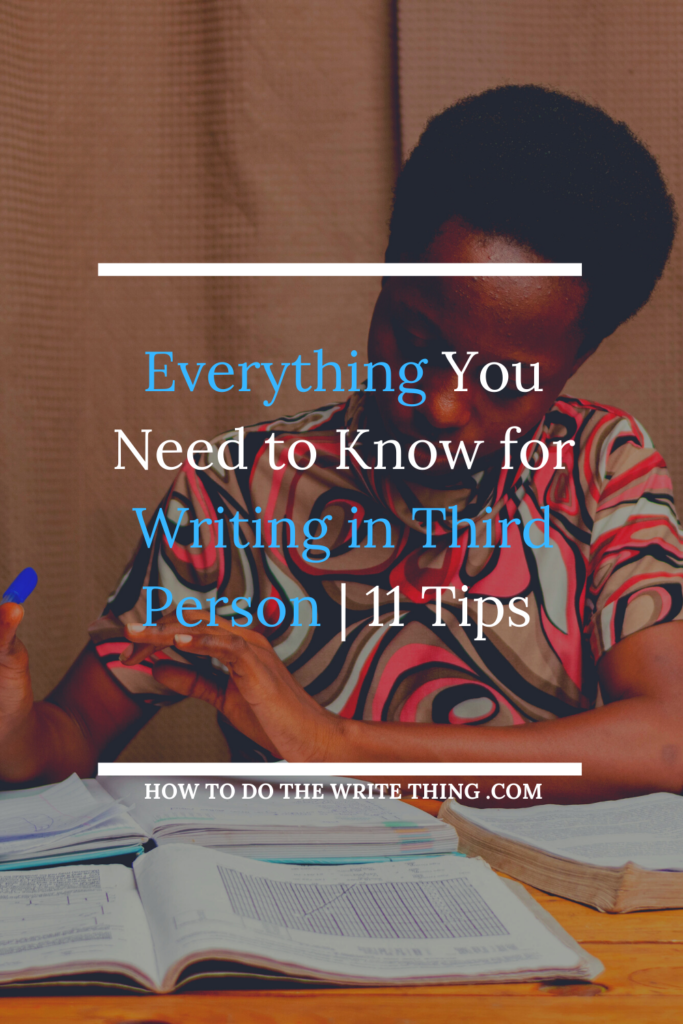
Make sure your posts are readable. Use this readability score check
Want to check out a writer’s community to test your writing and get feedback?
Want to know more about us?
Check out these FREE trial resources from Amazon for when you work from home (or are stuck at home 🙂 ) As an Amazon associate, if you do sign up or buy anything using Amazon links from our site we make a commission at no extra cost to you.
Free Prime Membership Trial:
Try Amazon Prime 30-Day Free Trial
Try Prime Discounted (Free Trial)
Make your Free Amazon Wedding Registry:
Create an Amazon Wedding Registry
Get Free Video Channels Trial with Prime:
Join Prime Video Channels Free Trial
Try a Free Amazon Family Trial:
Join Amazon Family (30-day Free Trial)
Get Unlimited Music for Free (30-day free trial):
Join Amazon Prime Music – The Only Music Streaming Service with Free 2-day Shipping – 30-day Free Trial
Free movies and TV shows trial:
Join Amazon Prime – Watch Thousands of Movies & TV Shows Anytime – Start Free Trial Now
Free Prime for students trial:
Prime Student 6-month Trial
Free Baby Registry:
Shop Amazon – Create an Amazon Baby Registry
Free trial of Twitch Prime:
Try Twitch Prime
And for when you REALLY work at home:
Create Amazon Business Account
It is the Amazon you love, for work. Make workplace procurement easier with convenient delivery options, simplified purchasing workflows, multiple payment options, and a competitive marketplace with business-only pricing and quantity discounts. Anyone who makes purchases for work (eg. procurement specialists, office administration, IT departments, etc.) can create a FREE account for their business. Customer must be from a verified business in order to successfully create their Amazon Business account.
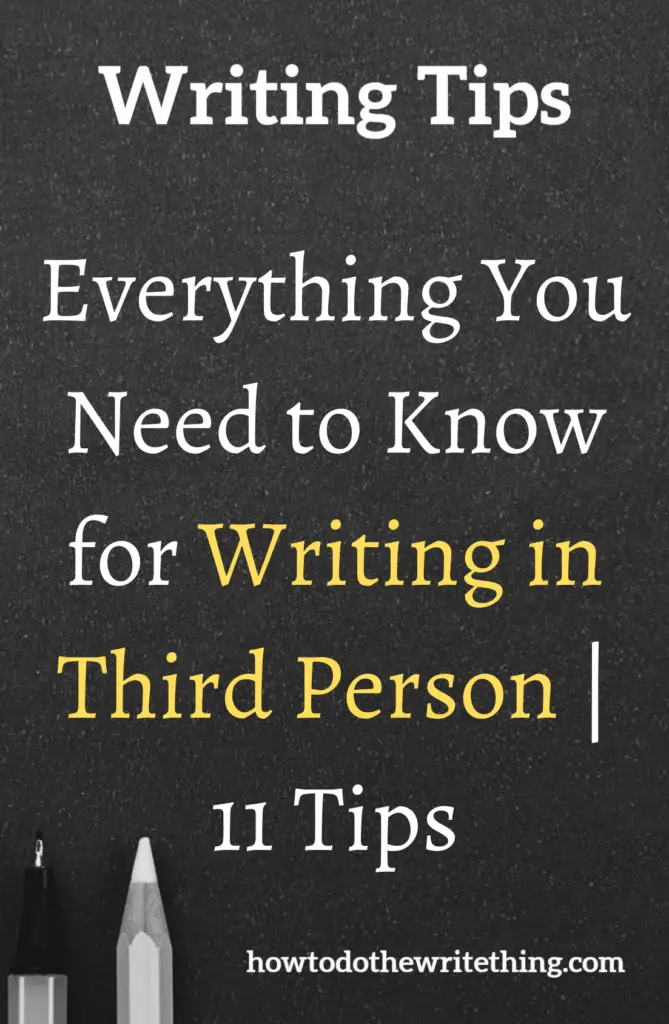
We hope you enjoyed: Everything You Need to Know for Writing in Third Person!
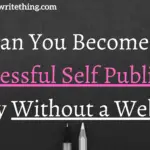
Can You Become a Successful Self Publisher Today Without a Website? I’ve seen this question before and thought it could Read more

5 Tips How to Make Editing More Enjoyable Editing can be a very dull process. At times, it can seem Read more

Can I Make My Story Setting in a Place I Have Not Been? You might be feeling trepidation about where Read more
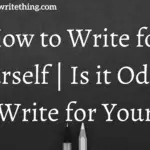
How to Write for Yourself | Is it Odd to Just Write for Yourself? Some people are out there writing Read more
Published by Jeremy
View all posts by Jeremy
Leave a Reply Cancel reply
Your email address will not be published. Required fields are marked *
Enjoy this blog? Please spread the word :)
- More Networks
- Features for Creative Writers
- Features for Work
- Features for Higher Education
- Features for Teachers
- Features for Non-Native Speakers
- Learn Blog Grammar Guide Community Events FAQ
- Grammar Guide
How to Write in Third Person Point of View

Sarah Oakley
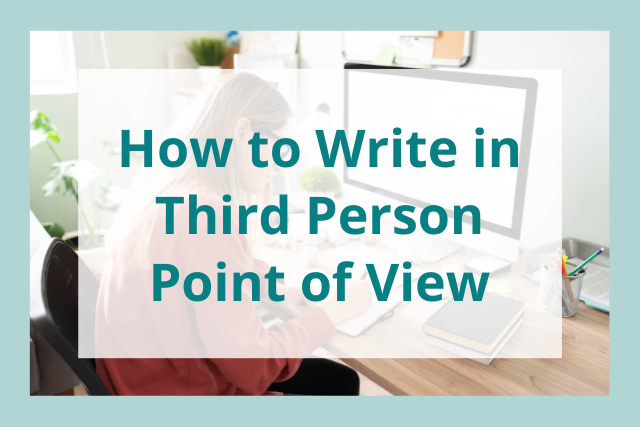
Whether you’re going to write a short story, a novella, or a novel, one of the most important decisions you’ll need to make is which point of view (POV) to use.
Third person is the most popular POV for fiction writers to use. It gives the reader a chance to experience the narrative from a perspective above, or on the shoulder of, the characters.
In this article, we’ll learn what the third person POV is, how it compares to other points of view, and how to write in third person point of view.
What Is Third Person Point of View?
Third person pov meaning, how to write in third person, third person pov examples, conclusion on how to write in third person pov.
Third person POV is when the narrator exists outside of the story. This narrator relates the actions of the characters by using their name or third person pronouns such as “she,” “he,” and “they.”
There are three types of third person POV that you can choose from. Each POV provides a different reader experience as they reveal different amounts of information about the narrative, characters, and setting.
To decide on a POV, think about the type of story you are telling and whether your readers need to be aware of certain details at each point in the plot.
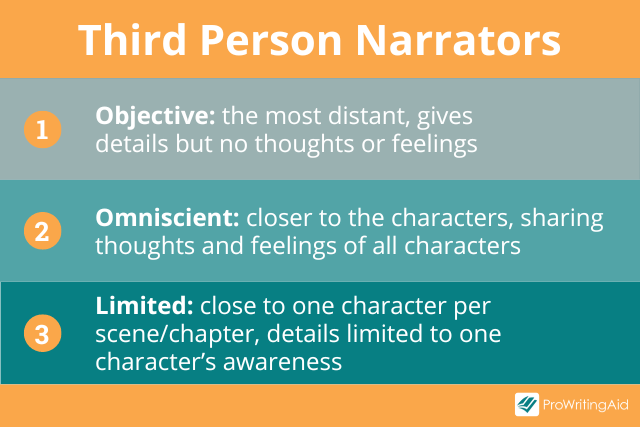
1. Third Person Objective Point of View
The third person objective POV is a way to tell your story by giving the reader all the details within the scenes without including what is going on in the characters’ minds.
To write in the third person objective POV, you will need to create an unbiased narrator who doesn’t tell the reader the thoughts and feelings of the characters. Instead, your narrator will simply relay the actions and dialogue of the story in an objective, impartial telling of the events.
This is great for keeping distance between the reader and the characters. It’s like looking through the window of a stranger’s house and trying to figure out why everything is happening.
2. Third Person Omniscient Point of View
When writing in the third person omniscient POV, you give your reader an all-access pass to the thoughts and feelings of any character in each scene of your story. You can give as much detail about the scene as you can in the third person objective POV, but this time you can also include information from the characters’ perspectives.
The narrator you create to speak in the third person omniscient POV will need to relay the thoughts and feelings of all the relevant characters in the scene. You can do this by switching perspectives. This is sometimes called “head hopping.”
You can use head hopping to show conflict in the story. For example, one paragraph is from the main character’s perspective, as they give some important information to another character. Then, the next paragraph is from the perspective of the person who received the information, which shows their reaction to what the main character just said.
Third person omniscient is perfect for sharing all the little details about the world you have created and allows the reader to pick up clues that some characters might not have noticed. Some writers refer to the third person omniscient POV as an all-seeing being who likes to give their thoughts on the plot.
3. Third Person Limited Point of View
This narrator sits on the shoulder of your main character and tells the story from their perspective. It’s close to being first person, but the reader isn’t solely within the character’s mind and this narrator still uses third person pronouns and verbs.
Sometimes, the third person limited POV narrator sticks to a different character each chapter instead of one character throughout the entire story. We refer to this as a viewpoint character, as we are seeing the world from their perspective.
You are controlling the amount of information given to the reader by focusing on one character’s awareness, rather than all characters’.
First Person vs Third Person
First person POV gives readers full access to the thoughts and feelings of the main character, as they are the one telling the story. There isn’t a narrator getting between the reader and the character.
Another key part of writing in the first person POV is that the character uses first person pronouns to tell the story. They use “I,” “me,” “my,” and “myself” as they are talking about actions and experiences.
Remember : not all main characters notice everything going on around them. It can break the reader’s immersion if they are wondering how the main character knew they were about to die, but there were no clues it was about to happen. Not all characters are psychic!
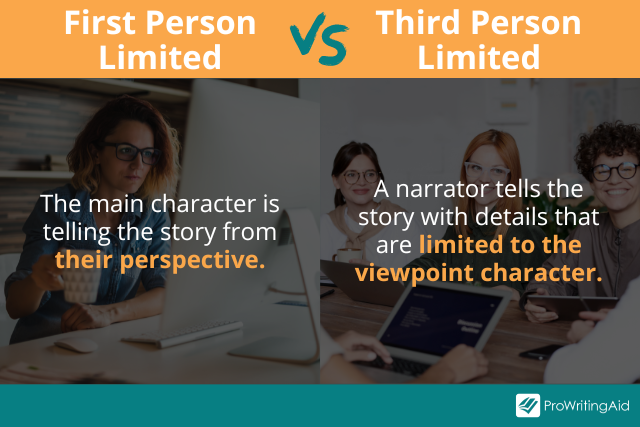
If you’re aiming to stick to one character’s thoughts and feelings, but you also want to add in some extra details that are in the character’s peripheral vision, try the third person limited perspective.
This POV can be used to great effect in thrillers where you want to stay close to the main character, so the reader connects with them.
Meanwhile, you can also give clues about things that are about to happen that the character is unaware of. Let us watch in horror as the character falls down a hole we all saw coming, but could do nothing to stop them.
Second Person vs Third Person
Second person POV puts you, the reader, in the driving seat as the main character. The narrator breaks the fourth wall and speaks to you directly.
This perspective uses second person pronouns such as “you,” “your,” and “yourself” to bring the reader into the narrative. The narrator uses third person pronouns to refer to other characters.
Second person works well in stories where you want full immersion for the reader. Some people love the feeling of being dropped onto the rollercoaster of drama in a good story. This is why second person is used in video games and Choose Your Own Adventure stories.
However, it is one of the least used POV types by fiction writers. One reason for this is that it takes a lot of skill to write about the reader in a way that feels natural to them while also giving away the right amount of information for the story. You don’t want your reader to lose interest because they don’t agree with something the narrator has said.
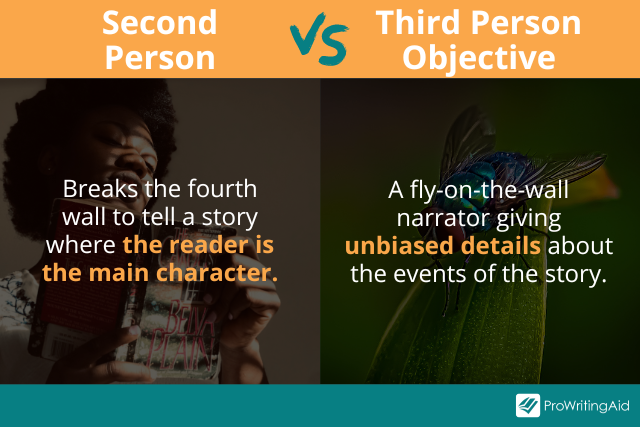
Third person objective would be a better option if you don’t want to write as though your story is about the person reading it. The third person POV allows the reader to focus more on the narrative and everything else that’s going on around the characters.
So far, we’ve discussed what the third person POV is, but what does the “third person” part of that mean?
Third person is a grammatical style of writing that uses pronouns such as “she,” “he,” “they,” and “it.” It also uses proper nouns and names when referring to specific individuals and objects.
1. Decide If Third Person Provides the Right Reader Experience
Do you want to tell the story from within the mind of your main character? Do you want to make the reader the main character of the story? If the answer is no to both questions, it’s time to look at your options for writing in the third person.
2. Pick the Type of Third Person Narrator
Go over the details of your story and your characters. You will need to establish whether third person limited, third person objective, or third person omniscient is the best POV for your story.
3. Read Examples of Writing in Third Person
It’s important to take the time to analyze what works and what doesn’t work in third person narration. The best way to do this is by reading other works that use third person points of view.
Focus on the information they are sharing. Did it work? Would you have used a different type of narrator for that story?
4. Use a Consistent POV
Switching POVs is a habit that a lot of writers do if they’re writing in a POV they’re not used to. Don’t worry, it happens. However, being aware that this is something to avoid before you get 200 pages into your novel and realize you switched POVs back on page 90 can help you be more observant of your writing habits.
5. Use the Correct Pronouns—ProWritingAid Can Help!
The third person POV means using third person pronouns when your narrator is speaking. Remembering this is one of the best ways to catch yourself from slipping into different points of view.
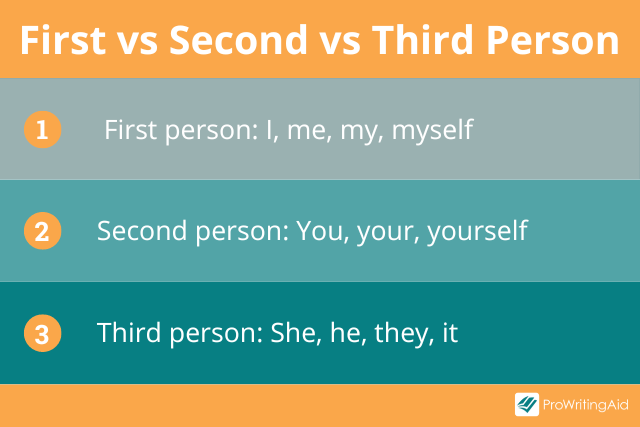
You can stop yourself from using the wrong pronouns by using ProWritingAid’s pronoun report. It’ll highlight all the examples of pronouns in your text, so you can easily work through your story and change them back into the third person if you’ve made any mistakes.
6. Create a Trustworthy Third Person Narrator
Your third person narrator is the voice of your narrative. How do they tell the story? Do we believe them?
Readers need to feel like your narrator has the authority to tell these events in a way that satisfies them. If you want to share the thoughts and feelings of the characters, the narrator needs to sound like they are confident in the details they are sharing.
Third Person Objective Example
If you’re wondering how to show conflict when writing in the third person objective POV, we would recommend reading Hills Like White Elephants by Ernest Hemingway.
Let’s look at an excerpt from the story:
The woman brought two glasses of beer and two felt pads. She put the felt pads and the beer glasses on the table and looked at the man and the girl. The girl was looking off at the line of hills. They were white in the sun and the country was brown and dry. “They look like white elephants,” she said. “I’ve never seen one.” The man drank his beer. “No, you wouldn’t have.” “I might have,” the man said. “Just because you say I wouldn’t have doesn’t prove anything.” The girl looked at the bead curtain. “They’ve painted something on it,” she said. “What does it say?” “Anis del Toro. It’s a drink.”
As you can see from this extract, the third person objective narrator is relaying the information about the scene without being biased to either of the characters. They do not quote the characters’ thoughts or feelings; they simply give details about their actions and words.
As a reader, you can still imagine what the characters are thinking and feeling, as the conflict is laid out bare for you to witness.
Third Person Omniscient Example
Readers of the third person omniscient POV expect the narrator to be all-seeing and all-knowing, so it makes sense that the narrator in Good Omens by Neil Gaiman and Terry Pratchett is “God” or the “Almighty.”
Here’s an extract from the novel:
“Er. Okay,” he said. “I’ll, er, be off then. Shall I? Get it over with. Not that I want to get it over with,” he added hurriedly, aware of the things that could happen if Hastur turned in an unfavourable report. “But you know me. Keen. So I’ll be popping along,” Cowley babbled. “See you guys... see you. Er. Great. Fine. Ciao.” As the Bentley skipped off into the darkness Ligur said, “Wossat mean?” “It’s Italian,” said Hastur. “I think it means food .” “Funny thing to say, then.” Ligur stared at the retreating tail-lights. “You trust him?” he said. “No,” said Hastur. “Right,” said Ligur. It’d be a funny old world, he reflected, if demons went round trusting one another.
This example shows how the third person omniscient narrator pops into the heads of several characters in one passage. At the beginning, we’re in Cowley’s mind, which is shown by the phrase “aware of things that could happen if Hastur turned in an unfavourable report.” However, within a few lines, we pop into Ligur’s mind, which is apparent in the sentence, “It’d be a funny old world, he reflected, if demons went round trusting one another.”
Third Person Limited Example
If you’re looking for examples of third person limited narrators that tell the story from one character’s perspective, we would recommend reading Happily Ever After by Harriet Evans.
Let’s check out a section of the novel:
She knew his face so well, knew him so well, how he drummed his fingers on any spare surface, how he looked vague when trying to get out of things, how his mouth curled to the side when he was making a joke. But she’d never sat this close to him before, because he was her boss. It didn’t feel like that tonight. It was as if they were different people. It was nice. Rory was nice, but then, she’d always known that.
Romance writers like writing first person POV, but third person limited also works well in this genre, like in this extract. The narrator is giving us a direct connection to the mind of the main character (Elle). They do this by describing everything Elle’s noticed about the man she’s attracted to.
Elle realizes her boss has always been nice and we get the impression she’s always secretly wanted to date him. The narrator shows us this by giving us Elle’s perspective on what’s happening in the scene. It’s as close as the narrator can be without Elle telling the story herself.
As you can see, writing in the third person isn’t hard when you follow the step-by-step process. It’s a lot of fun to experiment with the different types of third person POV. Which one do you prefer?
Don’t forget, if you’re worried about slipping into different POVs within your writing, you can always use the ProWritingAid pronoun report to keep you in check!

Be confident about grammar
Check every email, essay, or story for grammar mistakes. Fix them before you press send.
##About Sarah is a romance writer with a passion for studying human connections and psychology. She lives with her fiancé and two cats in Gloucester, UK. When she’s not writing, Sarah enjoys visiting theme parks, singing along to rock songs, and planning her next vacation. ##Writing Experience Sarah is an aspiring screenwriter who hopes to see her name in the credits of a romance film one day. She has also written short stories and has had many ideas for novels in a variety of genres. ##Education Sarah has been studying the art of writing and film from the age of 16 and she holds a BA in Creative Writing.
Get started with ProWritingAid
Drop us a line or let's stay in touch via :
- Anatomy & Physiology
- Astrophysics
- Earth Science
- Environmental Science
- Organic Chemistry
- Precalculus
- Trigonometry
- English Grammar
- U.S. History
- World History
... and beyond
- Socratic Meta
- Featured Answers

How do you write an essay in third person?

By putting it in third person, you are able to list sources, and you are encouraged to do so. That's why you're asked to write essays in third person.
This is the way your sentence should be:
School lunches are very bad because according to The New York Times , the 2012 Healthy Hunger-Free Kids Act causes children to not like how the food tastes, and so they do not eat it.
By writing in third-person, you are able to present evidence to your reader. So when you write in third person, show what you know, with evidence backing up your points.
It won't be as redundant as saying "I think/believe" or "I feel" when we know/hope you wrote the paper and you hopefully have sources to back up your claims.
Related questions
- Question #0c999
- What is a noun phrase in linguistics?
- Why is "internet" a proper noun?
- Which proper nouns should be capitalized?
- What are some examples of plural nouns?
- Can you change a common noun to a proper noun?
- What's the definition of a proper noun?
- What are some examples of collective nouns?
- What are some examples of common nouns?
- What are some examples of compound nouns?
Impact of this question

- WRITING CENTER
- CUSTOMER AREA
- Client Reviews
- Study Guides
- Questions & Answers
GET AN 'A GRADE' WITH OUR CUSTOM WRITING SERVICES!
Are you finding it difficult to complete your assignment while at home because of your home environment are you caught up with so many responsibilities; your family, work trip among others, yet you are expected to complete your homework customwritingservice.org is your homework solution 24/7 get your essay, research paper, thesis, project, report, etc done as per your instructions and within your deadline now.
- Academic Paper Writing Help
How to Write an Essay About Yourself in Third Person
We can help write your assignment right now we have helped thousands of students graduate successfully with top grades through our online writing..., are you looking for writing resources because of an assignment you are currently writing would like to partner with us for homework writing since 2009, we have successfully helped thousand of students with their assignments. we can help you right now; simply click on the order button below. if you are looking for study materials for your assignment, scroll down further, are you facing the following challenges we are exactly what you need.
- My Assignment is too difficult.
- I have too many assignment to handle
- I have a health related issue
- My assignment is too urgent
- I lack ideas on how to get started
- I have a family to take care of
- I have no time for my assignments
- I have a job/business to attend to
- I cant seem to get it right with my Professor
- I'm struggling to get resources for this paper
We have carefully selected the following resource to demonstrate our level of writing. If you are looking for a resource to write your paper, use this resource with proper citation. But should you consider to have someone write your paper, click on the ORDER button to get started with us. Thank you.
If you do not know how to write an essay about yourself in third person, there is no need to panic. With practice, writing this kind of essay can be quite simple. For academics, writing in third person simply means you must avoid the use of subjective pronouns such as “I” or “you”.
For creative writing differences exist between third person limited, episodically, omniscient and objective viewpoints. Select the one that fits the writing project you are working on. Third person tone uses formal language and requires rewording of ideas in certain cases, especially while writing narratives or making presentation of a personal research.
Tips on how to write an essay about yourself in third person
To effectively know how to write an essay about yourself in third person, there are a couple of tips that come in handy:
- Always use correct pronouns
When asked to write in third person, remember it refers to people “on the outside.” This means you can write about an individual by name or alternatively use third person pronouns.
- Some of these third person pronouns include: himself, he, she, it, her, his, its, it, him, them, they, herself, itself and they etc.
- Other peoples’ name are also considered as appropriate when writing in third person. For instance “ Susan believes differently. According to her research, earlier claims made on the subject are not correct.”
An excellent example can be found at fictionwriting.about.com. The example of Jane Austin for instance, provides a good sense on how to write an essay about yourself in third person.
- Do not use first person pronouns
First person is a form of writing in which the writer says things from their own personal experience. This form of writing is not only too personal but opinionated as well. It is important to void use of first person while writing your essay.
- First pronouns include: me, ours, our, ourselves, I, me, myself, us, we and mine etc.
- The main problem associated with use of first person in essays is that it sounds too subjective and personalized. This means it can be difficult to convince your reader ideas and views you express are not tainted or biased by your personal feelings. While using first person, it is likely to use phrases such as “in my opinion”, “I think” or “I believe”
Incorrect Example-Even though Susan thinks this way, I think his argument is incorrect.
Correct example-“Even though Susan thinks way, others in the field disagree.
- Avoid use of second person pronouns
Second person is a point of view directly addressing your reader. It is an indication of a lot of familiarity with your reader as you directly speak to them. Second person should not be used in your essay:
- Some second person pronouns include, yourself, you, yours or your
- The main problem with this form of writing is that it sounds accusatory hence it can place a lot of responsibility on the readers shoulder.
Incorrect Example: “If you still disagree today, then you must be ignorant of the facts”
Correct Example: “Someone who still disagrees today must be ignorant of the facts.”
- Refer to your subject in general terms
There are instance when you might need to refer to someone in terms that are indefinite. This means you might have to generally speak about an individual or address them. In such instance, use of indefinite noun or pronoun is more appropriate.
- Indefinite third person nouns include: the reader, the writer, individuals, a student, an instructor, woman, researchers, child, a man, experts, people, experts etc.
- Example: “Regardless of challenges involves, researchers continue in their claims.”
- Indefinite third person pronouns examples are everyone, one, someone, another, everybody, anybody, neither, either, each, anyone, everything and other etc.
Incorrect example: You might be tempted to agree without all the facts.”
Correct example: “One might be tempted to agree without all the facts.”- wikihow.com
- Keep an eye on plural and singular pronoun use
If you already know how to write an essay about yourself in first person, you know there are mistakes that must be avoided. The most common mistake made by writers using third person is making a switch to plural pronoun when the subject is supposed to be singular.
- Often, this is done to avoid gender specific “she” and “he” pronouns. In this instance, the mistake would be using plural “they” pronoun in place.
Incorrect Example: “The witness wanted to offer anonymous testimony. They’ were afraid of getting hurt if their name was spread.”
Correct Example: “The witness wanted to offer anonymous testimony. He or she was afraid of getting hurt if his or her name was spread.”
You can find more samples at examples.yourdictionary.com.
Three important guidelines to remember as you write your essay in third person
- Create a character
While writing a personal essay , you can do so by use of your own name or inventing a name instead of using first person pronouns such as us, me, us and me.
Using third person gives you the chance to write as if you were talking about someone else making it more interesting.
- Focus on your research
While writing in third person instead of using third person makes it easy to project your ideas. For example, rather than writing, “I selected 50 surveys a random and determined most students agreed with the policy,” write “Fifty randomly picked surveys revealed that most students agreed with the policy.”
- Rephrase your sentences completely
Always ensure that you revise your essay in order to get rid of the need for use of pronouns in sentences thus creating a formal style of writing that is more appropriate.
Incorrect Example: “The researcher’s technique required students to explain their survey answers if they choose ‘unsatisfied’. “
Correct example: Respondents needed to explain survey answers if selecting ‘unsatisfied’.”
Phrases such as ‘this writer’ create language that is awkward.
Additional tips on how to write an essay about yourself in third person
If you want to know how to write an essay about yourself in third person, these additional tips will come in handy:
Follow actions of many characters
While using third person, you can describe words or actions of a character at any place or time within your story.
- There is no need for a single main character for you to focus on. You have the freedom to switch between characters, following different characters through the narrative as the need arises
- Do not use first person terms such as “I” and second person terms such as “you” in the story.
Never make the attempt to get into a character’s head
While using this form of writing, you should not make any attempts to get into the mind of your subject. You are supposed to be the invisible bystander who observes the dialog and actions of characters within the story.
Incorrect example: After class, Jane raced from the room and went to the back of her dorm room. The lecture has made her so mad that she felt she could snap at the next person she met.
Show rather than tell
Though you cannot share the inner thoughts of a character while writing in third person, you can make some external observations suggesting what such internal thoughts could be. Describe what is happening rather than describe the facial, tone, body language or facial expression of the character.
Incorrect example: Jane was very prideful to cry in front of other people, however, she felt completely heart broken and began to cry once alone”
Correct example: “When no else was watching her, Jane began to cry.”
Do not insert your own thoughts
The reason behind use of third person is for you to act as a reporter rather than a commentator. Therefore:
- Let your reader draw his/her own conclusions. Present actions of your character without explaining or analyzing how the actions need to be viewed.
Incorrect example: “The action might seem strange but, Jane looked over her shoulder at least 3 times before she could sit down. This compulsive habit indicates her paranoid state of mind.
Correct Example: “Jane looked over her shoulders 3 times before sitting down”.
Get assistance on writing an essay in third person
Do you need assistance writing academic papers such as essays , term papers , research papers , dissertations among other academic papers ? We offer the best academic writing services online .
In addition we also offer dissertation editing and writing services at affordable rates. If you are interested in any our services get in touch with us here or visit our homepage to see what other services we offer and how we can assist you.
You may also want to continue reading more guidelines on writing different academic papers or other non-related material. To do so, continue looking in this blog where you will also find academic sample papers under different disciplines.
Online Sources
http://www.ehow.com/how_7833317_write-third-person-english-writing.html
http://www.wikihow.com/Write-in-Third-Person
Would you LOVE to have one of our Writers work on your assignment? Is your assignment on this topic or related to this? We can help! Click on the ORDER BUTTON to get Started.
We have created a system with a unique ordering process that is easy and secure. All you need is click on the ORDER BUTTON provided for in our website. Once the page is open, fill in your assignment details and submit. You will then be redirected to our payment platform, where you can pay via PayPal or Debit/Credit Card. We then start writing your paper; and once complete, the paper is sent to you via contacts provided.
Get Homework Help - Confidentially!
Probably you do not want your institution to know that you are using our services, right we get this concern all the time. the point is, you need help with your homework and we are here to help you as a business; so we ensure that privacy and confidentiality is guaranteed by maintaining communication strictly between you and us via email, live chat, calls or internal messaging system. we also ensure that each paper is uniquely done within your academic level - this helps with ensuring that your professor does not suspect that you hired someone to write your paper. get started with professional writing services for top grades., customers reviews simply tells our story - satisfaction guaranteed, a review section gives you a clear picture of what to expect when you use our services. this section is prepared for first time customers. the section helps customers learn from the experience of other customers..
Have been ordering from as many people online but never gotten A in my career, thanks for your assistance
Added 24 Minutes Ago
Have never believed before that a paper can be perfect unless I write it. I was travelling home for issues back there so I trusted your writer; he did best job ever. Will now come back for more.
Added 12 Hours Ago
I had little time on this one, but writer delivered in time even though it was long paper. paper looks perfect…just some little adjustments on referencing…thank you
Added 30 Minutes Ago
Hey, assignment on black holes needed minds men. Got no time and wondering how if I would make it. Thanks for finishing up on the job
Added 3 Minutes Ago
Lecturer accepted research proposal. Will submit to you more details how to complete the research paper
Added 6 Minutes Ago
Why should you have our professionals work on your assignment, each academic paper is unique in its own way. furthermore, each assignment has different specific instructions as stipulated by the instructor’s thereby key focus in placed on these basic requirements for each academic paper. this is why we offer customized writing services by making sure we customize the paper with regards to customer’s specifications. we also use your preferred sources if you wish so or we get our own sources. the other thing that we do as per your request is the number of words and pages. therefore when giving us your assignment, make sure that provide the instructions as given by your lecturer., free writing tips on our blog, get the best academic tips on how to write different papers free of charge. we are committed to ensuring that you become a stellar writer for better grades. visit our blog now, 24/7 customer support, we understand that your customer needs can arise any time. that is why our professional customer support team is ready to offer you services round the clock. order any time and get professional assistance., progressive delivery option, track the progress of your order any time any day. our professional writers will provide drafts upon request. you can fully trust our delivery process., timely delivery of assignments, do not let others to sacrifice your grades simply because you did not deliver in time. book our services and get your order done within the agreed timeframe. in fact, we deliver even before the deadline hits., plagiarism free papers, be ready to achieve the highest grades with our plagiarism free papers. we write all papers from scratch. all standards of citations and referencing are fully accounted for. we promise fully unique papers for all students., friendly customer care, our customer support team is a click or a phone call away. you will be met with high degree of friendliness any time you contact us. we treat each of our clients with respect and commitment. any time is your best time with our customer support., friendly team of experts, our company is simply a large family of experts dedicated to ensure that you enjoy maximum satisfaction. you can interact with any of our support members or writers with a guarantee of the best experience., confidentiality guarantee, we have for the last over 10 years operated within the best and strict confidentiality policy. we understand that your worry for exposure is immense. no need to worry anymore. we got your back, native english-speaking writers, it is our interest to ensure that you get a paper that has pure command of english grammar. our hiring policy strictly considers native english writers only. you can be assured of top-quality papers any time., multiple payment options, we provide our clients with absolute flexibility in terms of payment methods. we believe that you deserve the best services irrespective of the payment channel you use. pay via paypal, and all major credit cards., editing and proofreading services, we pride ourselves in hosting a team of the most professional editors and proofreaders. all papers are thoroughly scrutinized and refined before being handed to the client. we have zero room for errors., well formatted papers, we believe in delivering conclusive papers while attributing for all the necessary elements. your paper will be properly and rightly formatted based on your preferred style. all you need is to share all instructions and leave everything to us., highly researched papers, we simply do not air arguments without adequate research-based support. our team of professional writers are highly trained to embark on robust research to validate all arguments. it is indeed a sure bet for you., customized writing services, we capitalize in ensuring that all papers are customized based on your preference. we do not deal with ready-made papers. our commitment is to ensure that all papers are articulated and written from scratch., formatting and referencing, our team of versatile writers are able to format your paper based on the preferred style. we are experts in apa, mla, chicago, or any other style. we never get anything wrong as far as formatting and referencing is concerned., urgent assignment options, do not let your urgent assignment to subject you to frustrations. we are here to work on your urgent assignment without compromising quality. we will professionally handle your paper to precision even when the timeframe is stringent., free samples posted online, we understand that you may not have an idea on how to handle the task assigned to you. we therefore provide a lot of free samples in all disciplines. we are the best, money back guarantee, we understand that you have invested some of your money to pay for your assignment. this is enough to demand for money-back guarantee. we promise the best services, failure to which a refund is guaranteed., discounts to returning clients, we hold returning clients with the highest value. any returning client will be surprised with impeccable discounts on their orders. we believe that maximum satisfaction is what that matters to you. but we believe you can still enjoy better experience with lower prices., all subjects covered, we have the privilege of working with the most versatile and more so highly qualified writers. we therefore guarantee that all papers can be professionally handled, irrespective of the subject. any task is a walkover for us., within 3 minutes, you will be have submitted your assignment details for our review, yes, record time 3 minutes and you are done focus on other important issues and allow us to work on your papers. we have simplied the ordering process to increase efficiency on your part. try us today, fill out the order form:.
At this Point, simply submit your Assignment Instructions.
Submit the payment:
Submit your payment for your Order.
Order Processing:
Assignment Processing by both writer and Editors.
ORDER SUBMISSION:
Download your completed Paper.
To Get Started, Click on any of the button provided below!
A list of related papers on this category is provided below.
- Where to find a Reflection Paper Example
- What is an Essay Outline Template?
- Steps to Sustainable Competitive Advantage
- Free Essay: Apple Inc.
- What is the Law of Accelerating Returns?
- Molecular Evolution Discussion
- Free Essay: Challenges Facing Oil and Gas Industry
- Essay Writing Help on Paul Family Life
- The Holocaust
- Tips For Writing a Research Paper
- How to Write an Essay Fast in an Exam
- Tips on How to Write an Essay
- How to Write a Thesis Statement for High School Papers
- Free Essay: Challenges Facing African Union
- How to Write a Term Paper Introduction
- Temperate Broadleaf and Mixed Forest
- How to Write an Autobiography Book
- Free Essay: Issues Facing Australian Agriculture
- 5 Paragraph Essay Outline Graphic Organizer
- How to Write a Research Paper for Middle School
Are you looking for Free Academic Writing Resources on How to Write Papers?
- How to Write a Thesis for a Research Paper Examples
- How to Write a Thesis for a Research Paper
- How to write a Personal Cover Letter
- How to Write a Professional Mission Statement
- How to Write a Personal Autobiography
- How to Write a Performance Appraisal
- Tips on How to Write a Rhetorical Analysis Essay
- How to Write a 3.5 Essay Outline With Ease
- How to Write your Own Performance Review
- How to Write a Personal Statement for Graduate School
- How to Write Personal Statement for Scholarship
- How to Write Personal Statement for Residency
- How to Write Personal Statement for Law School
- How to Write Personal Statement for a Job
- How to Write a Personal Statement for College
- How to Write Personal Statement
- How to Write Personal Reference Letter for a Friend
- How to Write a Personal Reference Letter
- How to Write a Personal Profile for University
- How to Write Personal Profile in Resume
- How to Write a Personal Profile for Website
- How to Write Personal Profile for Marriage
- How to Write a Personal Profile for a Dating Site
- How to Write Performance Review Comments
- How to Write an Outline for a Research Paper
- How to Write an Introduction Paragraph
- How to Write an Introduction for a Research Paper
- How to Write an Introduction for an Essay
- How to Write an Introduction for a Book
- How to Write an Introduction About Yourself
- How to Write an Introduction
- How to Write an Expository Essay Step by Step
- How to Write an Expository Essay for STAAR
- How to Write an Expository Essay Thesis Statement
- How to Write an Essay Outline for High School
- How to Write an Expository Essay

IMAGES
VIDEO
COMMENTS
When writing in the third person about yourself, use your name or pronouns such as "he," "she," "it," or "they.". For example, you might say, "She always tries to be on time for her appointments.". You can also use a third-person point of view to describe other people in your life, such as family members or friends.
In a story, narrators use the third person if they are not part of the story themselves. Third-person narratives show us a person's actions, feelings, and thoughts. Example of how to write in third person: Nadia dreamt about being a gymnast her entire life. Ever since she can remember, she's worked hard, sacrificed a lot, and hoped someone ...
Writing in third person can be a simple task, with a little practice. For academic purposes, third person writing means that the writer must avoid using subjective pronouns like "I" or "you." For creative writing purposes, there are differences between third person omniscient, limited, objective, and episodically limited points of view.
In most contexts, you should use first-person pronouns (e.g., "I," "me") to refer to yourself. In some academic writing, the use of the first person is discouraged, and writers are advised to instead refer to themselves in the third person (e.g., as "the researcher"). This convention is mainly restricted to the sciences, where it ...
While "I" and "we" are both in the first person, "you" is used in the second person. Remember this rule, and you'll come up with an interesting essay or even a short story about yourself. You may even want to consider becoming a novel writer in the future after doing it. 3. Stick with "he," "she," "it," and "they".
Tip 1: Use third-person determiners and pronouns. In grammar, determiners introduce and modify nouns. They're used to specify what a noun refers to (like " my laptop") or the quantity of it (like " many sandwiches"). Meanwhile, pronouns are substitutes for nouns, referring to people, places, or things. For example, "Caroline [noun ...
6 tips for writing in third-person. 1. Understand your voice won't always shine in your essays. Every single piece of writing tends to have a voice or point of view as if you're speaking to the reader directly. However, that can't always happen in academic writing as it's objective compared to a novel, for example.
In some academic writing, the use of the first person is discouraged, and writers are advised to instead refer to themselves in the third person (e.g., as 'the researcher'). This convention is mainly restricted to the sciences, where it's used to maintain an objective, impersonal tone. But many style guides (such as APA Style) now advise ...
When writing in third person, speak with authority. Show your reader that the narrator's voice is trustworthy. Give them the inner thoughts of at least one character. The main narrator voice you use will give them the idea that you are in-the-know and can carry them well through the events to come. 2.
Focus on a specific moment, and describe the scene using your five senses. Mention objects that have special significance to you. Instead of following a common story arc, include a surprising twist or insight. Your unique voice can shed new perspective on a common human experience while also revealing your personality.
1. Third Person Objective Point of View. The third person objective POV is a way to tell your story by giving the reader all the details within the scenes without including what is going on in the characters' minds. To write in the third person objective POV, you will need to create an unbiased narrator who doesn't tell the reader the ...
Create a Character. When writing a personal narrative -- a story about an event that happened to you -- you can write in third person by using your first name or inventing a name rather than using first-person pronouns like I, me, we and us. Although most instructors allow students to use first person in such essays, the use of a name like ...
General Use of I or We. It is totally acceptable to write in the first person in an APA Style paper. If you did something, say, "I did it"—there's no reason to hide your own agency by saying "the author [meaning you] did X" or to convolute things by using the passive "X was done [meaning done by you].". If you're writing a ...
Three different points of view exist: first person, second person and third person. First person reflects the writer's voice with pronouns such as: I. me. we. us. Second person speaks directly to a reader, using pronouns such as "you" and "your." Third person uses a more general voice that reflects neither the writer nor reader specifically ...
Third-person writing is a style of writing that involves using pronouns such as "he," "she," "it," "they," or "one" to refer to individuals or objects instead of using first- or second-person pronouns like "I," "me," "we," "us," "you," or "your.". Third-person language is commonly used in academic ...
Writing in the third-person point of view is like hearing an announcer call a sporting event—a narrator gives a play-by-play of the plot from an outside perspective. As the author of a novel, you get to decide who tells your story. Writing in the third-person point of view is like hearing an announcer call a sporting event—a narrator gives ...
In literature, third-person point of view follows multiple characters and narrative arcs, zooming in and out of a story the way a camera does in a movie. A third-person narrator can be all-knowing (aware of every character's thoughts and feelings) or limited (focused on a single character, or aware only what certain characters say and do).
First person example (only acceptable for personal writing):. I think Shakespeare's play Hamlet is about the relationships between family members.I really liked the play, and in some ways the characters reminded me of my own family. Third person correction (appropriate for all other academic writing):. Shakespeare's play Hamlet deals with the relationships between family members.
Writing an autobiography in the third person can be a challenging creative writing exercise as well as a practical necessity for career development. Many companies expect you to write in third person when you describe your accomplishments. ... Whether you are writing about yourself for work or just stretching your creative muscles, writing an ...
Harvard College Writing Center 5 Asking Analytical Questions When you write an essay for a course you are taking, you are being asked not only to create a product (the essay) but, more importantly, to go through a process of thinking more deeply about a question or problem related to the course. By writing about a
An updated version of this mini lecture can be found here:https://www.youtube.com/watch?v=153FkM0YLt4&t=24sAlso, the example sentences in this video are not ...
Answer link. Third person point of view is when you are writing with third person pronouns (he, she, one, etc.) When you write an essay in third person, you do not refer to yourself in the essay, but instead use sources while writing. For example, this is not the way you write a sentence in your essay with third person: I feel as if school ...
Create a character. While writing a personal essay, you can do so by use of your own name or inventing a name instead of using first person pronouns such as us, me, us and me. Using third person gives you the chance to write as if you were talking about someone else making it more interesting. Focus on your research.